The 5 Stages of Entrepreneurship
Published: January 25, 2023
Entrepreneurship isn’t for the faint-hearted. Of course, the thrills of creating an effective business, working on your own terms, and enjoying financial freedom are rewarding. However, turning your idea into a profitable business is no simple task.

There will be hurdles to overcome. However, depending on your business idea, it may take months or years to scale these challenges and reach the finish line. Sadly, most entrepreneurs never see success. Nearly 75% of startups fail, according to Harvard Business Review .

The good news: Your business doesn’t have to be another casualty. In this post, you’ll learn the five stages of entrepreneurship and the common pitfalls you should avoid in each. You’ll also see real-life examples of entrepreneurs at each stage.

What are the five stages of entrepreneurship?
The “Five Stages of Entrepreneurship” is a simple framework that helps new founders to understand the entrepreneurship journey. The stages include ideation, planning, execution, scaling, and hypergrowth.
-jpg.jpeg)
The Five Stages of Entrepreneurship
Starting a business can seem like a daunting task. That’s especially true if you start the process without a roadmap.
The Five Stages of Entrepreneurship divide the startup journey into more manageable chunks. Each stage of your entrepreneurial enterprise will come with unique challenges. You’ll also need to complete certain foundational steps to set your business up for success.
Below, we explore the five stages of entrepreneurship and the common challenges to expect at each stage.
Stage 1: Ideation
Ideation is the first stage of every entrepreneurial journey. The goal here is to identify and validate a profitable business idea.
Here are three common ways entrepreneurs develop ideas:
- Considering what they’re passionate about. For a role model, turn to Nike Co-founder Phil Knight . His interest in shoes and sports strongly influenced his decision to start the athletic shoe company.
- Identifying a problem in an existing market. This is how the idea for Uber came about. Travis Kalanick and Garrett Camp were returning from a LeWeb, an annual tech conference. It was a cold winter night, and unfortunately, they couldn’t get a cab. So they asked themselves, “What if you could request a ride from your phone?” The rest is history.
- Focusing on niche markets . A niche market is a small, underserved segment of a large and established market. Jacamo, for instance, is a clothing retail company targeting larger (and taller) men who typically struggle to find large-sized, fashionable clothes.
After an initial brainstorming session, you’ll need to narrow your scope and focus on one idea. We’ll explain how you can validate concepts below.
Idea Validation
Ensuring the viability of your idea is essential. When you confirm the market need for your product, you avoid the risk of pouring your resources into a business idea that’s a dud.
Most entrepreneurs skip this crucial step. They assume there’s a market for their product without validating their hypothesis. The result? They build a product that no one wants, causing their businesses to die in infancy.
A CB Insights Report reveals this is one major reason businesses fail. Don’t make the same mistake. If you’re unsure of a market’s potential for your idea, think twice before committing resources to it.
How to Validate Your Business Idea
One way to validate your idea is to evaluate the performance of similar businesses. A perfect example is Chanty.
Chanty is a communication and team collaboration app that went head-to-head with companies like Slack. When Chanty came on the scene, Slack was already dominating the market and raking in millions of dollars in revenue. This proved to Dmytro Okunyev, Chanty’s Founder, that they could get a slice of the market.
You can also validate your ideas during discussions with trusted peers. As David Darmanin , Founder of Hotjar, says, “Step one of validating an idea is reaching out to your personal networks and gauge response. This differs from approaching friends and family who will always want to be nice to you.”
You can contact your network via email, social media, and many online communities. Done right, you can get free and unbiased advice that’ll help you iterate on your business idea quickly.
The lean start-up methodology also provides a comprehensive approach to testing business ideas. To learn more about the lean start-up, read this book by entrepreneur Eric Ries .
Stage 2: Planning
Just as architects need building plans to construct a new building, entrepreneurs need business plans to create successful businesses.
Developing a business plan helps you estimate costs, identify risks, and set up risk mitigation measures. A written business plan is even more essential if you’re seeking investors in your company. Potential investors want to see the extent to which you envisioned your business.
For this reason, put lots of thought into your plan, create a document that’s thorough, and consider your long-term goals.
Note that you don’t need to write a 37-page business plan or have a 15-year forecast before you begin building your business. As Mark Zuckerberg said , “Ideas don’t come out fully formed. They only become clearer as you work on them. You just have to get started.”
So if you don’t have a five-year vision of your business yet, don’t let that stop you from taking the first few steps while you flesh out the big picture.
Stage 3: Execution
Like a plane stuck on a runway, many budding entrepreneurs often generate some momentum, but they never lift off. As a result, many innovative ideas never become a reality.
The fact is, ideas are a dime a dozen, but execution is rare. To succeed, you’ll need to become adept at putting a plan into action.
At least once per day, I hear a great business idea (often web3). But then I tell people -- Excellent, you have a great idea... now you have to execute on it! Most people fail at this stage, and can't turn a great idea into great execution -- which is what really matters — Brian D. Evans (@BrianDEvans) May 16, 2022
Starting a business is risky and scary. And that feeling of uncertainty — the fear of failure and of making mistakes is one of the major reasons entrepreneurs hesitate to execute.
If you’ve identified and planned out your big idea, you’re probably filled with the excitement of “what could be” and the fear of “what if it doesn’t work?” simultaneously.
You’re not alone. Founders like Dmytro Okunyev had these mixed emotions, too.
I wasn’t very certain that my idea would work, but step by step, small win by small win, I gained that confidence. Now we are in the ivy league of communication platforms. #chanty #software #marketing — Dmytro Okunyev (@dmytrookunyev) February 12, 2021
Today, Chanty is thriving because Dmytro mustered the courage to move forward with his plans despite the uncertainties.
So, recognize that your plan isn’t foolproof. You will make mistakes. But just as you can’t paddle a boat tied to the dock, you can’t steer your business toward your vision until you launch and tackle your mistakes head-on.
As Mark Zuckerberg explains : “Don't even bother trying to avoid mistakes because you're going to make tons of mistakes… The important thing is actually LEARNING QUICKLY from whatever mistakes you make and not giving up.”
Moving too slow or too fast is dangerous. So caution is necessary either way. Develop a good sense of when to act fast, get rid of your desire for perfection, and know when to slow down.
Will Rogers, a popular American vaudeville performer, puts it more humorously: “Even if you’re on the right track, you’ll get run over if you just sit there.”
The bottom line: business is trial and error. Make peace with the fact that you’ll make mistakes. Take small calculated bets. Learn from the resulting failures and move forward.
If you believe in your idea, you’ve tested it, the timing feels right, and you have assembled your team , then launch!
Stage 4: Scaling
At this point, you’ve successfully launched your business, you’ve achieved product-market fit , and sales are steady — but your business hasn’t reached the heights you imagined. You desire to expand faster.
So you face an important question: “Should you bring in external investors and give up equity or bootstrap your business, i.e. self-fund through personal savings, debt, or customer funding?”
Founders of successful companies often bootstrap in their early days, but eventually, they accept outside investment. However, outliers like Spanx bootstrapped their way to a unicorn valuation after founder Sara Blakely started the undergarment company using only $5,000 of her personal savings.
Bootstrapping relies on a lot of sweat equity. This can mean taking on more stress than an investor-funded company. Blakely, for instance, learned to write her own patent from reading books so she could save $3,000 in legal fees.
Bootstrapping has a huge but sometimes overlooked upside. Besides giving you full control of your business, the lack of capital forces you to find smart ways to grow your company.
Heavy funding covers up problems that ought to be obvious to the founders. Paradoxically, this sometimes leads to start-up death. On the flip side, accelerated growth is one major benefit that investor-backed start-ups enjoy. GitHub , an internet hosting service for software development, is an example of a business that scaled fast , thanks to external funding.
Tom Preston-Werner, Chris Wanstrath, and PJ Hyett founded GitHub in 2008 and funded it for four years. In 2012, they got their first VC investment of $100 million and raised another $250 million in 2015. By October 2018, their annual recurring revenue was between $200-$300 million. Microsoft bought GitHub for $7.5 billion in the same year.
Whether your bootstrap or get investor backing, three factors are crucial for scaling your business quickly:
- Building effective systems. A system is a structure that fuels the smooth running of your business without your presence or supervision. These systems clearly outline how your company operates.
- Learning to lead. Learn to sell a vision to your team. You must be able to inspire others to act. This way, you leverage other people’s talents and experience to achieve results. Alone, you can only go so far.
- Track your profitability. It’s not unheard of to find a business with $50 million in revenue but $200k in profit. That’s why you shouldn’t focus on growing sales alone. Instead, obsessively track your margins and brainstorm ways to increase them.
To learn more about how to build systems, read:
- The E-Myth Revisited: Why Most Small Businesses Don't Work and What to Do About It
- Built to Sell: Creating a Business That Can Thrive Without You
Stage 5: Hypergrowth
Hypergrowth is a season of rapid and exponential growth that companies experience as they scale. Specifically, an organization experiences hypergrowth when its Compound Annual Growth Rate (CAGR) exceeds 40% and remains so for at least a year, according to the World Economic Forum .
For context, “normal growth” companies have a CAGR of 20%. “Rapid growth” companies have a CAGR of 20% to 40%. Some companies that have achieved hypergrowth include Amazon, Slack, Stripe, Zoom, Uber, and Bolt.
Achieving hypergrowth is desirable but challenging. One common setback is the risk of employee burnout from overwork. A prolonged period of unprofitability is another prevalent challenge.
Amazon, for instance, was unprofitable for its first 20 years . It became profitable only in the mid-2010s. If investors had pulled out or stopped injecting cash into Amazon, its collapse would have been inevitable.
However, “Jeff had earned so much faith from his shareholders that investors [were] willing to patiently wait for the day when he decides to slow his expansion and cultivate healthy profits,” writes Brad Stone in his acclaimed book, The Everything Store.
This pattern of pursuing hypergrowth at the expense of short-term profitability is the norm with high-growth businesses. As of 2019, 64% of unicorns that IPO-ed since 2010 are unprofitable, according to TechCrunch . But investors don’t seem to care.
To enter this phase of exponential growth, focus on the following three factors.
1. Product Innovation
Hypergrowth is demand-driven. So unless you build a product that customers love, you’ll never get there. Harsh, but true.
Customer-centricity is an obsession for (all) hypergrowth businesses, not just a “core value” they hang on the walls. They constantly leverage empathy, data, and customer feedback to build the best products.
2. Agile and Scalable Systems
What got you to $10 million in ARR won’t get you to $900 million. The systems that run small businesses efficiently will not support your hypergrowth.
Uber had to overhaul its driver onboarding process multiple times to support its hypergrowth. Until 2013, intending drivers had to go to a local office to complete some paperwork. Then they morphed into an online application process that allowed drivers to sign up without visiting a local office.
And when they began international expansion , the company had to design another process to accommodate the differences in regulations across host countries.
3. A Core Team
Hypergrowth is driven by hyper-effort. That’s why long work hours are common in hypergrowth companies. It’s a hard grind. And if you don’t have a team that shares your passion and believes in your mission, you’re not going far.
Whatever you do, don’t try to achieve hypergrowth too fast. Companies attempting to scale prematurely often push their operational capabilities to the limit, increase their stress levels, and hurt their business reputation.
To learn more about hypergrowth, read:
- Blitzscaling: The Lightning-Fast Path to Building Massively Valuable Companies
The bottom line is this: if you have an idea for a product that helps people solve a problem, don’t ignore it. Test it. Iterate until you get product-market fit. Combine that with a thoughtfully planned business strategy, a dedicated team, and a group of experienced mentors, and your business could become an enormous success story.
The process of growth will be demanding and painful. And sometimes, the people closest to you won’t share your vision. Nike’s controversial ad offers advice on what to do when people scorn you.
As Steve Jobs said, “The people who are crazy enough to think they can change the world are the ones who do.”

Don't forget to share this post!
Related articles.

The Business of Helping Gen Alpha Manage Their Millions

Sound Investment: Tap Into The $2 Billion Audiobook Market

How This Swag Startup Made $3.3 Million in Year One

Fast and Fabulous: Tap into The Billion-Dollar Gourmet Convenience Market

8 Seaweed Startups Riding the $18.4B Green Wave

10 Best Etsy Alternatives to Sell Your Crafts

4 Opportunities in The $884B Home Improvement Business

How Dylan Jacob Scaled BrüMate to $100m+ in 5 Years

7 Opportunities to Make Life Easier for New Moms (and Make Money)

Digital Scent: A $1.2B Market Primed for Innovation
2 Essential Templates For Starting Your Business
Powerful and easy-to-use sales software that drives productivity, enables customer connection, and supports growing sales orgs
2.1 Overview of the Entrepreneurial Journey
Learning objectives.
By the end of this section, you will be able to:
- Explain the entrepreneurial journey to explore and discover entrepreneurship as a career choice
- Identify the steps, decisions, and actions involved in the entrepreneurial journey
- Recognize the rewards and risks of the steps in the entrepreneurial journey
Self-Employment as an Entrepreneurial Journey
When the economy and the job market are strong, the entrepreneur has a safety net that decreases the risks in creating a new venture , a startup company or organization that conducts business or is created to satisfy a need, and allows for a quick recovery if the venture is not successful. There are more new startups when there are high levels of confidence in both the venture’s success and the entrepreneur’s confidence in finding employment if the venture fails. People over 40 years of age account for most new startup activity, in part because of the continuing trend in which a business may choose not to hire an employee but instead hire an independent contractor , a person who provides work similar to an employee without being part of the payroll for the contracting business, and who is responsible for paying their own taxes and providing their own benefits. With previous knowledge and expertise, this group of entrepreneurs recognizes opportunities created by this move away from hiring full-time employees to more outsourcing to independent contractors. One contributor is the gig economy , which involves using temporary and often transitional positions hired on a case-by-case basis, rather than keeping a full staff of hired employees. Advantages for the employer include a decrease in cost of benefits and loyalties to specific employees. Advantages for the hired worker or independent contractor (sometimes called a freelancer ) include no long-term commitment and flexibility in accepting contracts. From an entrepreneurial perspective, the creation of websites that support the gig economy offers opportunities for independent ventures. Many people today are becoming small entrepreneurs. This process goes by a variety of names, such as the sharing economy , the gig economy, the peer economy , or the collaborative economy . Maybe it means driving for a company such as Lyft , Uber , or GrubHub , or perhaps offering services through TaskRabbit , UpWork , or LivePerson . The projected numbers of independent contractors and on-demand workers are stated as 42 percent for small businesses by the year 2020, a growth of 8 percent from current figures. 1 And a projection of greater than 50 percent of the workforce will be independent contractors by 2027 if this trend continues at the current pace. 2 In the “Freelancing in America: 2019” report, the sixth annual study by UpWork and Freelancers Union, 57 million United States citizens are estimated to freelance, with income approaching 5 percent of US gross domestic product (GDP) at nearly $1 trillion and earning a median rate of $28.00 an hour, representing an hourly income greater than 70 percent of workers in the overall US economy. 3 One report found that 94 percent of net job growth from 2005 to 2015 was in alternative work categories, with 60 percent due to independent contractors and contract company workers. 4
According to the US Bureau of Labor Statistics, the number of self-employed Americans is growing, with 9.6 million self-employed people at the end of 2016. That number is expected to grow to 10.3 million by 2026. 5 A more recent study by FreshBooks’ second annual “Self-Employment” report predicts that 27 million US employees will leave traditional work in favor of self-employment by 2020, tripling the current population of full-time self-employed professionals to 42 million. The main driver for this change in the workforce is a greater desire for control over one’s career with the ability to have greater control over working hours and acceptance of work. 6 , 7 Of course, self-employment is a broad category that includes small-business owners as well as entrepreneurial startups and freelance gig employees. Since 2016, there has been a downward slide in the number of employees working for self-employed businesses, which results from a variety of factors, including difficulties in finding qualified employees, qualified employees having more employment options, such as employment through the gig economy, outsourcing activities, and technology actions that decrease the need for employees, with entrepreneurial activity remaining steady. 8
Entrepreneurship around the World
In a 2017 Business Insider article, “America Needs Immigrant Entrepreneurs,” David Jolley writes that immigrants constitute 15 percent of the US workforce and 25 percent of the country’s workforce of entrepreneurs. 9 Forty percent of startups include at least one immigrant. Jolley’s article cites a study that identified immigrants as twice as likely to start a business as people born in the United States. In 2016, 40.2 percent of Fortune 500 companies were founded by at least one immigrant or a child of immigrant parents. Dinah Brin, writing for Forbes , stated in a 2018 article that immigrants form 25 percent of new US businesses and that new immigrant-owned firms generated 4 to 5 million jobs. 10
These statistics and other findings have prompted countries such as Canada to revise their immigration policies to attract more entrepreneurial-minded immigrants. A World Bank report from May 2018 ranked the United States 53rd out of 190 countries for ease in starting a business, with higher scores representing greater ease. 11 The same report ranks the United States eighth for ease of doing business. The difference in these rankings indicates that once a business is established, factors such as regulations, permits, access to credit, and infrastructure support the business owner’s ability to continue the business, but actually starting the business is more challenging. For any given country, ease in starting a business and the country’s interest in supporting entrepreneurial activity are crucial in both attracting entrepreneurial people and supporting their ability to open a business. Imposing restrictive regulations and processes on new ventures significantly decreases the number of new ventures.
According to a 2018/2019 report, the highest rate of entrepreneurial activity worldwide in 2018 was in Angola at 41 percent. 12 Angola’s low-income economy meant fewer employment opportunities, creating pressures to find other ways to earn an income. Guatemala and Chile reported 28 percent and 25 percent of entrepreneurial activity, respectively, with medium- and high-income economies. These percentages are quite high, considering that these economies offer employment opportunities in existing companies. In terms of innovation, India at 47 percent, and Luxembourg and Chile at 48 percent each, take the lead in offering new products and services not previously available. This entrepreneurial activity reflects the ease of starting a business. The Netherlands, Poland, and Sweden were reported as the easiest countries in which to start a new business, in part because many people in those countries view entrepreneurship as an attractive lifestyle. As you can see, both economic opportunities and a country’s specific support for entrepreneurial behavior contribute to the number of people who enter entrepreneurial activities.
From a gender perspective, there are currently over 11 million woman-owned businesses in the United States. This number includes both small business owners and entrepreneurs. Thirty years ago, there were only 4 million woman-owned businesses. 13 The number of woman-owned businesses has increased 45 percent between 2007 and 2016, five times faster than the national average, with 78 percent of new women-owned businesses started by women of color.
Starting Your Entrepreneurial Journey
How do you fit into this entrepreneurial journey? This chapter will help you to explore and discover your potential for entrepreneurship as a career choice. Think of this exploration and discovery experience as a way to map out a strategy to reach your goals or dreams. Let’s imagine that your dream vacation is a hiking trip to Glacier National Park in the US state of Montana. Just as hikers have different levels of experience, so do entrepreneurs. Just as your plan for a wilderness hike would involve many stages, your entrepreneurial journey involves multiple levels of self-discovery, exploration, experiences, and accomplishments on your way to success. For our purposes, the term entrepreneurial venture means any type of new business, organization, project, or operation of interest that includes a level of risk in acting on an opportunity that has not previously been established. For each story of entrepreneurial success that is shared—such as that of Facebook or Airbnb—there are even more lesser-known entrepreneurial success stories such as Zipline , a company that delivers medical supplies in Rwanda and Ghana by drone. These entrepreneurs faced the same dilemmas in pursuing their passion, or opportunities, which led them to their entrepreneurial destiny. They courageously stepped out of their comfort zones to explore the possibilities that lie ahead. What is the difference between entrepreneurs and you? The main difference is taking that first step. Many people have ideas that fit into the definition of an entrepreneurial idea but never take that first step. Just as the Chinese philosopher Lao Tzu suggests, every journey begins with a single step.
Are You Ready?
Taking the first step.
Go to Fire Nation’s website on taking the first step to learn more. Changing your mindset (your perception of yourself and your life situation) and encountering trigger events (significant external situations) can nudge you into taking the first step toward being an entrepreneur.
- Is there a venture you’ve always thought you should start but never did?
- Think about what factors are stopping you. Consider your mindset and how you might change your mindset so that your venture could become a reality.
- What are some possible trigger events that could make the difference between starting your venture and waiting to start your venture?
Opening your future to the possibility of starting your own venture brings new and exciting experiences ( Figure 2.2 ). Every entrepreneur moves through several steps in considering the entrepreneurial journey. Once you understand this journey, the steps will help you define your path toward creating and starting your new venture. Each step of this process offers another level of understanding that prepares you for long-term success. How will you achieve this success? By taking one step at a time, exploring and learning, considering new ideas and expectations, and applying these experiences to achieve your personal outcome. Think of the entrepreneurial journey as a guide to knowing what is in store for you as you start your new venture.
One benefit of outlining a step-by-step process is the opportunity to explore different paths or behaviors that may lead to an entrepreneurial venture. Think again of your dream visit to Glacier National Park. How would you get there? What equipment would you need? What kinds of experiences would you expect to have? Think of the Glacier National Park journey as your entrepreneurial journey, a metaphor intended to help you as you create your career as an entrepreneur.
What makes someone ready or willing to choose entrepreneurship over becoming an employee of an established business or a small business owner? It takes confidence, courage, determination, resilience, and some know-how to select entrepreneurship as a career as well as the recognition of the opportunity. An entrepreneur is defined as someone who not only recognizes an opportunity but who also is willing to act on that opportunity. Both actions are required. We might identify an opportunity, but many people do not act on the idea. Confidence, courage, and willingness are necessary to take that first step, as well as remembering the following:
- You are unique. Even if two similar people attempted to launch identical ventures, the results would likely not be the same. This is because each one of us has different ideas, approaches, available resources, and comfort levels, all of which influence the venture’s development and eventual success.
- Although there are no hard and fast rules or theories of the best way to launch into entrepreneurship, we can gain wisdom from the lessons learned by experienced entrepreneurs.
- Selecting an entrepreneurial career requires honesty, reflection, and a tendency to be action oriented. You will need to recognize your own strengths, limitations, and commitment as part of that honesty. Reflection is required for self-growth—seeking improvements in your own skills, interactions, and decision making—and commitment is required to maintain consistency in your willingness to make the new venture a top priority in your life. You will also need to understand that you cannot accomplish everything by yourself, and you may need to ask for help. It helps to be curious, open, and able to take calculated risks and to be resourceful and resilient when faced with challenges or obstacles.
Entrepreneurial Potential Self-Assessment
Take this quick Entrepreneurial Potential Self-Assessment to assess your potential to become an entrepreneur. After completing this self-assessment, what new information did you learn about yourself? Do you think your answers will change as you acquire more life experiences and education? Why or why not?
Optimizing Interest Areas
What are three areas that interest you? These could be hobbies, work activities, or entertainment activities. How would someone else describe your skills and interests, or what you are known for? Answering these questions provides insights into your strengths and interests. Next, what is one area that you are passionate about? What strengths could you bring to this passion to build your own business?
Keep an open mind in looking for an opportunity that fits your strengths and interests. If you decide to explore entrepreneurship, what would be your first step? What are your initial thoughts about being an entrepreneur? What would you review or search to find more information on your idea or area of interest? With whom would you first question or discuss this idea? Why?
The Entrepreneurial Journey as a Trip
The entrepreneurial journey is your exploration to discover if entrepreneurship is right for you. Every entrepreneurial journey is unique; no two individuals will experience it in the same way. Along the way, you will find opportunities and risks coupled with challenges and rewards. It’s useful to think about the entrepreneurial journey as an exciting trip or other adventure. Most of the preparations and steps involved with planning a trip are like those for starting a venture. Just as you would plan and prepare for a trip—starting with inspiration and leading up to finally traveling on the trip—you might follow similar steps to launch a venture. And just as you would prepare for any challenges that you might encounter on a trip—bad weather, lost luggage, or detours—so you should consider potential obstacles or barriers along your entrepreneurial journey ( Figure 2.3 ). Think of these difficulties as opportunities to learn more about the entrepreneurial process—and about yourself and how you manage challenges.
Developing a venture can be an exciting and active experience. It is also a lot of hard work, which can be equally rewarding and enjoyable. Here we present the entrepreneurial journey as seven specific steps, or experiences, which you will encounter along the road to becoming an entrepreneur. You’ll find more information about the entrepreneurial journey in other chapters in this book.
- Step 1: Inspiration – What is your motivation for becoming an entrepreneur?
- Step 2: Preparation – Do you have what it takes to be an entrepreneur?
- Step 3: Assessment – What is the idea you plan to offer through your venture?
- Step 4: Exploring Resources – What resources and characteristics do you need to make this venture work?
- Step 5: Business Plan – What type of business structure and business model will your venture have?
- Step 6: Navigation – In what direction will you take your venture? Where will you go for guidance?
- Step 7: Launch – When and how will you launch your venture?
As you work through each step of the entrepreneurial journey you should prepare for significant aspects of this experience. You will meet with rewards and challenges, the consequences that result from the decisions made at various points along your journey. To visualize the steps of the entrepreneurial journey, imagine your possible hiking trip to Glacier National Park ( Table 2.1 ). Just as hikers have different levels of experience, so do entrepreneurs. Compare the following aspects of preparing for a hike with aspects of your entrepreneurial journey.
Step 1: Inspiration
When you think of being an entrepreneur, what is the inspiration for your venture? Just as you might have an inspiration for a hiking trip to Glacier National Park, you will have an inspiration behind the decision to become an entrepreneur. When you’re planning a trip to a new and exciting place, one thing you might do is to imagine what you will experience along the journey and on arriving at your destination ( Figure 2.4 ). This portion of the entrepreneurial journey includes imagining yourself as an entrepreneur or as part of an entrepreneurial team. For this stage, you need a creative, open, and innovative state of mind, also known as an entrepreneurial mindset , which is discussed in more detail in The Entrepreneurial Mindset and Creativity, Innovation, and Invention . Dream big about your potential future and opportunities ( Figure 2.5 ).
Step 2: Preparation
Just as when you are preparing for a trip, you need a plan ( Figure 2.6 ) to move forward on your entrepreneurial journey. Before your dream hiking trip, you might gather information about Glacier National Park from a trusted source, such as a good friend with travel experience, or you might conduct online research. Your friend’s feedback could be just the motivation you need to try this experience yourself. Or you might use your research to determine if the trip is possible. You will need to look at maps, either online or on paper. Either way, you might also consider travel and accommodation options, such as booking a flight and finding a place to stay. You might want to create benchmarks to align your journey with your available resources, such as the amount of time and the amount of money you have to spend on the trip. Benchmarking is a method of tracking target expectations with actionable results by comparing one’s own company’s performance with an industry average, a leader within the industry, or a market segment. Benchmarking can help design the trip to meet incremental goals and timelines. From both a travel plan and an entrepreneurial perspective, although benchmarking is used as a control mechanism, we know that situations can arise that require an alteration in the plan, causing the benchmarked items to also need adjustments.
Link to Learning
Which type of benchmarking will help you the most in beginning your entrepreneurial journey? Visit the American Society for Quality’s resource page on benchmarking for help.
To plan for an entrepreneurial journey, you should first conduct some preliminary research regarding your venture idea. Your research must be honest and objective if it is to give you a clear picture of the venture. Next, you might organize and prioritize your research and thoughts. For instance, you might see an idea like yours online or on television, and feel disappointed that someone stole your great idea or beat you to the punch. This is a common occurrence in entrepreneurship, but it should not discourage you. Instead, use that knowledge and energy to find an overlooked or different aspect of your original idea. The difference might even be the focus on a different target market , a specific group of consumers for whom you envision developing a product or service. Further, it is critical to maintain a fluid focus upon expanding the scope of a product or service to uniquely differentiate provisions of benefits apart from existing benefits or those offered by competitors. A focus on a different target market is exactly how the Jitterbug smartphone was created, because it targeted senior citizens. The Jitterbug smartphone offers a larger screen, larger buttons, and simpler features that make it easier for older people to make quick calls or send texts.
Preparation also includes opening space in your life to the time and energy commitment needed to support your new venture. Are the important people in your life willing to support the interest and passion you will need to dedicate the time, energy, and other resources to this new venture? Review the questions shown in ( Figure 2.7 ) to consider your answers to these questions. Preparation through research and other activities is discussed in more detail in Identifying Entrepreneurial Opportunity .
Step 3: Assessment
Now that you have decided where to go for your trip and have gathered information to prepare for it, the next action is to create and set your schedule. This action is simple but critical, because it involves connecting and coordinating information and resources that fit your lifestyle and needs. For example, you might schedule an early-morning Uber or Lyft to the airport and electronic delivery of your plane tickets to your smartphone. For the entrepreneurial journey, this phase might also include recognizing appropriate relationships and gathering needed resources. For many entrepreneurs, the opportunity to receive guidance from trusted advisors or mentors may provide valuable insights on how to manage the process. This step allows for reflection on your idea and intentions. After you’ve done your researching and gathering knowledge about your idea through the preparation step, is the idea still viable? Is the idea still interesting to you? With a better understanding of the industry, your idea, and your own interests that you gained in Step 2, is this idea something that you still want to explore? This step is discussed more fully in Problem Solving and Need Recognition Techniques with deeper coverage on the topic of opportunity recognition ( Figure 2.8 ).
Step 4: Exploring Resources
Regardless of where you might travel, you could not complete your trip without adequate resources such as available financing. There are many ways you might fund a hiking trip: savings, loan, pay-as-you-go, sponsorship (family or friends), or any combination of these options, to name a few. No matter how you finance your trip, it might help to have a balance of available credit and cash on hand to support your day-to-day expenses and any extracurricular activities or even unforeseen emergencies. As discussed in Entrepreneurial Finance and Accounting , the US Small Business Administration (SBA) provides funding opportunities.
This scenario is mirrored in the entrepreneurial journey. Just as you wouldn’t begin a trip without adequate resources, including access to cash, you wouldn’t begin your entrepreneurial journey without the necessary resources, including cash. The options between funding a trip and funding a new venture are similar, but they have different names. For example, on a trip, you might use the cash you have on hand, from savings or a personal loan. For an entrepreneurial journey, you might address cash management —management of cash inflows and outflows to support cash needs of the venture—to include bootstrapping , a funding strategy that seeks to optimize use of personal funds and other creative strategies (such as bartering) to minimize cash outflows. (See Entrepreneurial Finance and Accounting for more information on bootstrapping.) Bootstrapping includes ideas like leasing instead of purchasing, borrowing resources, or trading unneeded resources for needed ones. Another example of cash management includes a business model that offers subscriptions rather than a payment received for an item purchased. Subscriptions provide the entrepreneur with cash up front, with the buyer receiving benefits throughout the year. Consider the example of Amazon. Amazon offers Prime with a yearly subscription service, as well as Subscribe & Save , Amazon Instant Video , Amazon Mom , and Amazon Web Services , all based on a subscription business model.
According to Entrepreneur.com, other potential subscription-based models include services or products geared to older consumers, with 8,000 people turning sixty-five every day. A similar idea offers services to college students. Both ideas would offer family members a subscription that sends monthly gifts or products to either the elderly person or college student. We also see this model offered to pet owners who pay a monthly subscription to receive treats and toys for the family dog. Looking back at Amazon, we see the company offering the ease of repeat purchases for frequently used products such as vitamins and air filters.
Entrepreneur In Action
Prospurly is a subscription-based company that uses Cratejoy ’s subscription platform to sell small-batch artisanal products for bath, body, and home, marketing a natural lifestyle focused on the happiness of living a simple and appreciated life. Conduct your own research on Prospurly and other subscription-based businesses. Read the article, “How I Built a Subscription Business That’s Made over 50k in 6 Months,” on Cratejoy for more information about this company and Prospurly’s move from ideation to profitability.
Other ideas for finding funding include applying for grant funding. The importance of cash and cash management requires in-depth coverage, which is presented in Entrepreneurial Finance and Accounting and Business Structure Options: Legal, Tax, and Risk Issues .
The idea of exploring resources includes many other options besides how to fund a new venture. In a trial run , you would offer your product or service for sale within a limited market on a test basis to evaluate what additional resources are needed to support the success of the venture ( Figure 2.9 ). Examples of places where a trial run fits well, depending on your product, include farmers markets, in-home sales, or through friends and family. The idea is to track the feedback you receive about your product or service. How do people react to the price, the quality of the product, the packaging? You can experiment by selecting one variable to adjust—changing the price, the packaging, the sales pitch, the presentation, or the quantity—to track reactions and make improvements based on this feedback. You may then decide to adjust other variables to gather more information, as well as considering what other resources are needed for the success of the new venture. Financing and ideas to preserve your financial stability are discussed more fully in Entrepreneurial Finance and Accounting .
Step 5: Business Plan
The ability to travel and visit new locations is a privilege and a great opportunity to gain exposure to new experiences and opportunities. In addition to the work involved in preparing for a trip, the act and process of traveling involves constant decision making to achieve your desired goals and outcomes. For instance, should you travel to one location in Glacier National Park and explore that area in depth? Or should you attempt to visit as many areas of the park as possible with your given resources and abilities?
The challenge at this step of your entrepreneurial journey is to remain focused on managing your resources to meet your goals and outcomes as you write your business plan for your new venture. You will need to focus on the skills, experience, and resources necessary for your venture, and the management and decision making required to ensure success and adjust your plan based on changes and new information. Just as you might find a location in Glacier National Park where you want to stay for a couple of nights, a deviation from your original business plan (discussed in Business Model and Plan ) will also require adjustments and changes based on new information and insights.
Be honest with yourself by running a reality check about your ability to manage a venture, especially from a personal-capacity perspective. For example, if you start a business, will it be a part-time or full-time venture? Will you start while in school? Or will you wait until after graduation? The timing of opening the venture can be the difference between success and failure. Consider the difference between hiking in Glacier National Park in the middle of winter, when the daytime temperature is thirteen degrees below zero, and hiking in the middle of summer, when the daytime temperature is seventy-nine degrees. The timing of your visit to the park is an important part of your enjoyment and success in reaching your destination. In planning for your trip, you would pay attention to your departure time to ensure enjoyment and success in your adventure. Similarly, as part of your business plan, you would also research the best time to open your venture.
Finally, during your travels, getting lost, overwhelmed, or sidetracked is always possible. If you get lost when traveling, you might refer to social navigation apps such as Google Maps , Waze , or HERE WeGo , to find turn-by-turn directions and information. Or you might refer to a weblink, a printed map, or a local expert or guide familiar with the area. The business plan is your map. You should identify decision points and milestones , significant key accomplishments, in your plan. Milestones could include points such as hitting your breakeven point , the point at which income from operations results in exactly enough revenue to cover costs. If the financial projections in your business plan are unattainable, what is your next move within the plan? If you don’t reach the milestones identified in your business plan, what alternative choices can you make to redirect your venture? The business plan, in its first draft, should inform you whether your venture has a chance at success. If there are negative areas, what can you change? Building this plan before starting the business provides you with knowledge and insights about your idea. Make any necessary changes to the plan to strengthen the possibility of success. Then when you open the venture, track whether the reality of the venture aligns with your business plan’s projections and expectations. The business plan functions as both a road map to help you see where you are going next in building your venture and as a checklist to track whether you are on course or need to make adjustments. When entrepreneurs get off track, they can check out self-help websites, speak with a business coach or counselor, or contact local agencies or organizations, including those affiliated with the federal SBA. Organizations that offer free (or low-cost) small business counseling, mentoring, and training, include:
- SCORE (Service Corps of Retired Executives): https://www.score.org/
- Small Business Development Center (SBDC): https://www.sba.gov/offices/headquarters/osbdc/resources
- Women’s Business Center (WBC): https://www.sba.gov/local-assistance/find/?type=Women%27s%20Business%20Center&pageNumber=1
- US Export Assistance Center: https://www.export.gov/welcome
- Veterans Business Outreach Center (VBOC): https://veteransoutreachcenter.org/
- Other organizations include locally organized support such as pop-up entrepreneurial schools like PopUp Business School (https://www.popupbusinessschool.co.uk/) and https://www.pbs.org/newshour/show/this-free-program-trains-people-how-to-start-a-business-but-without-debt
These and other resources will be discussed in more depth in Building Networks and Foundations . Look at the review questions and the discussion questions at the end of this section to prepare for creating your business plan. Business plans ( Figure 2.10 ) are discussed more fully in Business Model and Plan .
Step 6: Navigation
Once you’ve completed your trip, reflect on the experiences you had. No matter how well you feel you have planned, there is no way you can prepare for all of the potential challenges, changes, and obstacles that may occur: missed or changed flights, poor weather, an unexpected illness, a trail or road closed for repairs, or sudden good fortune. What parts of the trip went well? If you ran into a problem, how did you handle it? Was the problem something you could have anticipated and planned for? Or was it unexpected? What did you learn from the experience? If you were planning a trip to another national park, what would you do differently in your planning stage? Just as seasoned travelers adjust to their circumstances and learn from their experiences, so should you, as an entrepreneur, learn to adjust by meeting and managing challenges head on.
After completing your business plan, you will probably need to adjust your plan ( Figure 2.11 ). You might decide that you will not have enough resources to survive the time until your venture reaches the breakeven point, or you might determine that the location you selected is no longer available. There are multiple variables that require further exploration and research.
By nurturing an entrepreneurial mindset , you will be better prepared when opportunities, challenges, or obstacles surface. Although you won’t be able to predict or plan for every potential scenario along the entrepreneurial journey, an entrepreneurial mindset helps you to be resourceful when opportunities, challenges, or disappointments occur. By unpacking, or by taking an inventory of your available resources, you can also get a better picture of what you may need to unload, retain, or discard, or even if a new direction is the best course of action. On your entrepreneurial journey, evaluating the experience or situation is a perfect opportunity for you to determine how realistic, overambitious, or shortsighted your dreams and goals for your venture may be. This chapter will explore your vision for your future and your venture. Does your vision include a level of flexibility when you discover new information that supports exploring a new area?
Step 7: Launch
The actual launch is the exciting event when you open your business. By this point, you have made improvements to your product through feedback received in your trial run; you’ve identified the value or benefits provided by your product; you’ve identified your target market; and you’ve identified the location of your launch, whether it is a geographical location or an Internet location.
Inc . magazine provides an analysis of the best locations to launch a new venture, with Austin, Texas, taking the lead (see “Surge Cities: These Are the 50 Best Places in America for Starting a Business,” in Suggested Resources ). Consider your target market and the resources necessary to support your venture when choosing the location for your launch. Advice from within the entrepreneurial world suggests that sometimes the launch should take place “under the radar,” meaning in a location where you can make mistakes, fine-tune your business model and offerings, and even become successful without competitors noticing that you have created a disruption within the industry. (You will learn more about this in Launch for Growth to Success ).
Even as you are launching your venture, many variables will require your attention, just as we covered in Step 7. Navigating through these variables as your venture grows requires constant attention as new potential opportunities arise.
Sixto Cancel and Think of Us
Sixto Cancel successfully faced the harsh challenges of aging out of the foster-care system without adult support or guidance. He imagined a better foster-care system for young people then cofounded the firm Think of Us. Think of Us is a platform that helps young people in foster care build their own personalized digital advisory board of supportive adults who act as a virtual life-coaching group. The adults guide the young people through the foster-care system and ensure that they are able to become independent when they leave the system at age eighteen. For more information about this venture, visit www.thinkof-us.org.
- 1 David Pridham. “Entrepreneurs: Here’s Good News for 2018.” Forbes . 2018. https://www.forbes.com/sites/davidpridham/2018/01/10/entrepreneurs-heres-good-news-for-2018/#660f5ebd6659
- 2 UpWork and Freelancers Union. “Freelancers Predicted to Become the U.S. Workforce Majority within a Decade, with Nearly 50% of Millennial Workers Already Freelancing, annual ‘Freelancing in America’ Study Finds.” UpWork . October 17, 2017. https://www.upwork.com/press/2017/10/17/freelancing-in-america-2017/
- 3 UpWork. “Sixth Annual ‘Freelancing in America’ Study Finds That More People Than Ever See Freelancing as a Long-Term Career Path.” UpWork . October 3, 2019. https://www.upwork.com/press/2019/10/03/freelancing-in-america-2019/
- 4 David Pridham. “Entrepreneurs: Here’s Good News for 2018.” Forbes . 2018. https://www.forbes.com/sites/davidpridham/2018/01/10/entrepreneurs-heres-good-news-for-2018/#660f5ebd6659; Lawrence F. Katz and Alan B. Krueger. “The Rise and Nature of Alternative Work Arrangements in the United States, 1995–2015.” 2016. https://scholar.harvard.edu/files/katz_krueger_cws_final_nov2018.pdf.
- 5 Elka Torpey and Brian Roberts. “Small-Business Options: Occupational Outlook for Self-Employed Workers.” US Bureau of Labor Statistics . May 2018. https://www.bls.gov/careeroutlook/2018/article/self-employment.htm
- 6 Carly Moulton and Dave Cosgrave. “Second Annual Self-Employment Report.” FreshBooks . 2017. https://www.freshbooks.com/wp-content/uploads/2018/04/2018selfemploymentreport.pdf
- 7 OECD Data. “Self-employment Rate.” OECD.org . n.d. https://data.oecd.org/emp/self-employment-rate.htm.
- 8 Arnobio Molrelix. “The Biggest Reason the U.S. Needs Small Businesses to Thrive Has Nothing to Do with Taxes or the Economy.” Inc ., Dec. 20, 2018. https://www.inc.com/arnobio-morelix/inc-entrepreneurship-index-2018-q3.html
- 9 David Jolley. “America Needs Immigrant Entrepreneurs.” Business Insider . September 5, 2017. https://www.businessinsider.com/america-needs-immigrant-entrepreneurs-2017-9
- 10 Dinah Wisenberg Brin. “Immigrants Form 25% of New U.S. Businesses, Driving Entrepreneurship in ‘Gateway’ States.” Forbes . July 31, 2018. https://www.forbes.com/sites/dinahwisenberg/2018/07/31/immigrant-entrepreneurs-form-25-of-new-u-s-business-researchers/#10ee8099713b
- 11 “Ease of Doing Business Rankings.” Doing Business . May 2019. http://www.doingbusiness.org/en/rankings
- 12 Niels Bosma and Donna Kelley. “Global Entrepreneurship Monitor 2018/2019 Global Report.” GEM Consortium . January 21, 2019. https://www.gemconsortium.org/report/50213
- 13 Gary Stockton. “Statistics and Obstacles Facing Women Entrepreneurs.” Experian . January 29, 2018. http://www.experian.com/blogs/small-business-matters/2018/01/29/statistics-and-obstacles-facing-women-entrepreneurs/
As an Amazon Associate we earn from qualifying purchases.
This book may not be used in the training of large language models or otherwise be ingested into large language models or generative AI offerings without OpenStax's permission.
Want to cite, share, or modify this book? This book uses the Creative Commons Attribution License and you must attribute OpenStax.
Access for free at https://openstax.org/books/entrepreneurship/pages/1-introduction
- Authors: Michael Laverty, Chris Littel
- Publisher/website: OpenStax
- Book title: Entrepreneurship
- Publication date: Jan 16, 2020
- Location: Houston, Texas
- Book URL: https://openstax.org/books/entrepreneurship/pages/1-introduction
- Section URL: https://openstax.org/books/entrepreneurship/pages/2-1-overview-of-the-entrepreneurial-journey
© Jan 4, 2024 OpenStax. Textbook content produced by OpenStax is licensed under a Creative Commons Attribution License . The OpenStax name, OpenStax logo, OpenStax book covers, OpenStax CNX name, and OpenStax CNX logo are not subject to the Creative Commons license and may not be reproduced without the prior and express written consent of Rice University.

- Case Studies
- Free Coaching Session
Lessons Learned: Key Takeaways from My Entrepreneurial Journey
Last Updated:
May 10, 2023

Embarking on the path of entrepreneurship can be an exhilarating, albeit challenging, adventure. Over the years, I've encountered numerous trials and triumphs, each contributing valuable lessons to my overall growth and development as a business owner.
In this edition of The Fearless Business Blog , I'll be sharing some of the invaluable lessons I've learned throughout my entrepreneurial journey, delving into how they have shaped my mindset and contributed to my overall success. By understanding and applying these key takeaways, you too can navigate your own entrepreneurial endeavours with greater confidence and clarity.
Key Takeaways on My Entrepreneurial Journey
- Embrace failure as a learning opportunity : Understand that failures are an essential part of growth and can provide valuable lessons for future success.
- Build a strong support network : Surround yourself with like-minded individuals who can offer guidance, encouragement, and collaboration as you navigate your entrepreneurial journey.
- Prioritise personal well-being : To maintain peak performance and avoid burnout, it's crucial to find a healthy work-life balance and prioritise self-care.
- Deliver value to your customers : Focus on providing exceptional products and services that solve real problems for your clients and exceed their expectations.
- Stay adaptable and resilient: The entrepreneurial landscape is ever-changing, so it's essential to remain flexible and resilient in the face of challenges and evolving circumstances.
- Continuously learn and grow : Invest in your personal and professional development to stay at the forefront of your industry and maintain a competitive edge.

1. Embrace Failure as a Learning Opportunity
One of the most critical lessons I've learned is that failure is an essential part of the journey. When we experience setbacks or disappointments, it's vital to recognise them as opportunities to learn and grow. By embracing failure as a stepping stone towards improvement, you'll be better equipped to adapt, pivot, and ultimately achieve your desired outcomes. Furthermore, acknowledging that failure is inevitable allows you to approach it with curiosity and resilience, using each setback as a chance to refine your strategies and strengthen your resolve.
2. Build a Strong Support Network
No entrepreneur can succeed in isolation. Building a robust support network of mentors, peers, and like-minded individuals can be a game-changer in your entrepreneurial journey. These connections not only provide guidance and encouragement but also help you stay accountable and motivated. Make it a priority to join networking groups, attend industry events, and engage with fellow entrepreneurs through social media platforms. In addition, consider forming or joining a mastermind group, where you can regularly share ideas, resources, and support with like-minded individuals who are also on their entrepreneurial journey.
3. Prioritise Your Personal Wellbeing
It's easy to get caught up in the hustle and bustle of entrepreneurship, often neglecting our own mental and physical wellbeing . However, maintaining a healthy work-life balance is crucial for long-term success. Schedule time for self-care, exercise, and relaxation, ensuring that you are at your best when making important decisions and driving your business forward. Moreover, be mindful of burnout and the negative effects of chronic stress on your overall health. By prioritising your wellbeing, you'll not only foster greater personal satisfaction but also boost your productivity and effectiveness in your professional life.
4. Master Your Mindset
Developing a positive and resilient mindset is fundamental to overcoming obstacles and achieving success as an entrepreneur. Recognise your limiting beliefs and replace them with empowering thoughts that propel you towards your goals. By cultivating a mindset of abundance, confidence, and determination, you'll be better equipped to handle challenges and seize opportunities that come your way. Additionally, practice gratitude and focus on the positive aspects of your journey, as this will help you maintain an optimistic outlook and foster a greater sense of fulfilment.
5. Invest in Continuous Learning
In the fast-paced world of entrepreneurship, it's essential to stay ahead of the curve by continually updating your knowledge and skills. Dedicate time to learning about industry trends, mastering new tools, and refining your craft. By committing to lifelong learning, you'll ensure that you remain agile, innovative, and competitive in your chosen field. Furthermore, consider investing in professional development opportunities, such as workshops, courses, and certifications, to expand your expertise and enhance your credibility in the eyes of your clients and peers.
6. Focus on Providing Value
One of the most effective ways to stand out in a crowded market is by consistently delivering value to your customers. Focus on understanding your target audience's needs and pain points, and tailor your products or services to address these challenges. By establishing yourself as a trusted and reliable solution provider, you'll foster loyalty, drive repeat business, and ultimately grow your enterprise. Additionally, prioritise exceptional customer service and consistently exceed your clients' expectations. By nurturing strong relationships with your customers, you'll not only enhance your reputation but also generate valuable word-of-mouth referrals.
7. Cultivate Resilience and Adaptability
The entrepreneurial landscape is ever-evolving, requiring business owners to be adaptable and resilient in the face of change. Embrace change as an opportunity to grow and evolve, rather than a threat to your existing strategies. Stay informed about industry developments and market shifts, and be prepared to pivot when necessary. By demonstrating flexibility and resilience, you'll be better positioned to capitalise on new opportunities and weather any storm that comes your way.
8. Establish Clear Goals and Measure Progress
Setting clear, specific, and measurable goals is vital to tracking your progress and maintaining focus on your entrepreneurial journey. Break down your long-term objectives into smaller, actionable steps, and continually assess your progress to ensure you stay on track. Regularly reviewing and adjusting your goals will help you stay aligned with your vision and make informed decisions about the direction of your business. Moreover, celebrate your milestones and accomplishments along the way, as this will boost your motivation and remind you of the progress you've made.
9. Delegate and Outsource
As your business grows, it becomes increasingly challenging to manage all aspects of your operations single-handedly. Learn to delegate and outsource tasks, allowing you to focus on your core competencies and higher-value activities. By entrusting specific tasks to skilled team members or external professionals, you'll not only enhance efficiency but also free up time to strategise and drive your business forward.
10. Embrace the Power of Collaboration
Collaboration can be a powerful catalyst for growth and innovation in your entrepreneurial journey. Seek out partnerships and joint ventures that align with your values and objectives, enabling you to expand your reach, leverage complementary skills, and unlock new opportunities. By embracing collaboration and pooling resources with like-minded entrepreneurs, you'll be better positioned to scale your business and achieve long-term success.
FAQs on Lessons for Entrepreneurs
As you embark on your entrepreneurial journey, you'll likely encounter numerous challenges and opportunities for growth. To help you navigate this exciting and sometimes daunting path, we've compiled a list of frequently asked questions and their answers. In this FAQ section, we'll explore valuable insights and advice gleaned from years of experience, addressing topics such as learning from failure, building a support network, prioritising well-being, delivering customer value, and more. By understanding these key takeaways, you'll be better equipped to overcome obstacles and achieve success in your entrepreneurial endeavours.
How do I learn from failure and turn it into a valuable experience?
Embrace failure as an opportunity to gain valuable insights and grow both personally and professionally. Analyse what went wrong, identify areas for improvement, and apply these lessons to future endeavours. Developing a growth mindset will help you view failures as stepping stones towards success, rather than setbacks.
How can I build a strong support network?
Begin by connecting with like-minded entrepreneurs, mentors, and industry professionals through networking events, online forums, and social media platforms. Seek out individuals who share your values and can provide guidance, encouragement, and constructive feedback. Additionally, consider joining mastermind groups or enrolling in relevant courses to further expand your network and gain valuable insights.
How can I prioritise my well-being while running a business?
Develop a daily routine that incorporates self-care practices such as regular exercise, healthy eating, and sufficient sleep. Schedule downtime and set boundaries between your personal and professional life to prevent burnout. Remember that taking care of your physical and mental well-being is crucial for maintaining productivity and achieving long-term success.
Why is it essential to focus on delivering value to my customers?
By consistently providing value to your customers, you'll enhance customer satisfaction, loyalty, and trust in your brand. This focus on value can lead to repeat business, positive word-of-mouth referrals, and long-term success. Ensure that your products or services cater to your target audience's needs and continuously improve your offerings based on customer feedback.
How can I cultivate resilience and adaptability in my entrepreneurial journey?
Stay informed about industry developments, market shifts, and emerging trends to anticipate change and capitalise on new opportunities. Embrace change as a chance for growth, and be prepared to pivot your strategies or business model when necessary. By demonstrating flexibility and resilience, you'll be better positioned to navigate challenges and achieve long-term success.
What's the best way to delegate and outsource tasks in my business?
Begin by identifying tasks that can be delegated or outsourced, such as administrative duties, social media management, or content creation. Then, entrust these tasks to skilled team members or external professionals who specialise in the required areas. This approach allows you to focus on your core competencies and higher-value activities while ensuring your business runs efficiently.
How can I leverage the power of collaboration to grow my business?
Identify potential partners or collaborators who share your values and objectives, and explore opportunities for joint ventures, partnerships, or co-marketing initiatives. By pooling resources, skills, and knowledge with like-minded entrepreneurs, you can unlock new opportunities, expand your reach, and drive innovation in your business.
In conclusion, entrepreneurship is a journey filled with challenges, growth, and transformation. By learning from and applying these key takeaways, you can navigate your own path with greater confidence and resilience. Embrace failure as a learning opportunity, build a strong support network, prioritise your wellbeing, and continually invest in your personal and professional development. Stay focused on delivering value, embrace change, and leverage the power of collaboration to propel your business to new heights. Remember, your entrepreneurial journey is unique, and the lessons you learn along the way will ultimately shape your success and fulfilment.
People Also Like to Read...


Boost Your Business Strategy: Top Tips from Robin Waite, Business Growth Expert

Robin Waite - Business Coach, Author and Speaker
© 2016 - 2024 Robin Waite. All rights reserved.
7 ideas to inspire your entrepreneurial journey
Illuminate your journey as an entrepreneur with these insightful talks primed to inspire the current and future generations of female founders ready to embrace new heights of success.
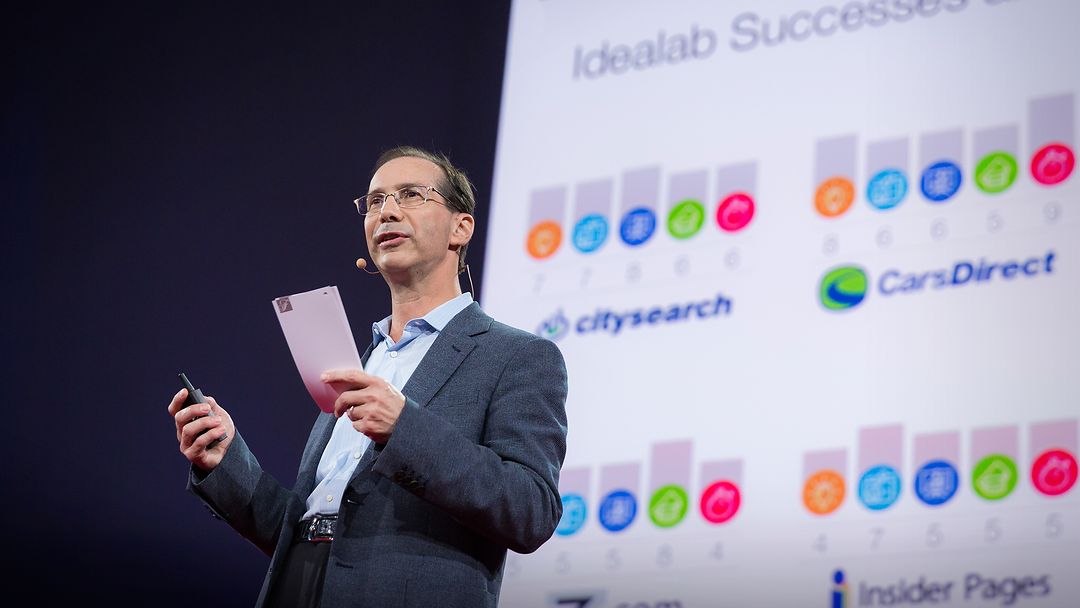
The single biggest reason why start-ups succeed

2 questions to uncover your passion -- and turn it into a career

Why some of us don't have one true calling

4 lessons the pandemic taught us about work, life and balance

How to have constructive conversations

Possible futures from the intersection of nature, tech and society

The routines, rituals and boundaries we need in stressful times
- This is an Ad-Free website
- Learn AI Jobs skills
- Blockchain Courses
- Digital Jobs Offers

Embarking on an entrepreneur’s journey is like setting sail towards a dream, full of aspirations of success, autonomy and personal fulfillment. A path that begins with brilliant optimism but often encounters unexpected challenges and complexities.
Every entrepreneur starts with a dream. This dream isn’t just about financial gain; it is the vision of creating something unique, a business that embodies your passion and values. It is the dream of creating a future that promises not only monetary rewards, but also a sense of personal fulfillment and lifestyle enrichment.
However, reality for many entrepreneurs deviates from this dream , soon turning it into a nightmare.
Throughout this article, I will provide you with the knowledge and tools to navigate this complex landscape.
4 Stages of an Entrepreneur Journey
The initial dream, with visions of success and personal gratification, may be in stark contrast to reality. Many entrepreneurs may be faced with personal difficulties, not least the lack of work-life balance .
One of the critical issues is the gap in entrepreneurial education . Many entrepreneurs embark on their journey without the skills and knowledge needed to run a business effectively.
So let’s see what components need to be considered in order to be successful.

1. Strategy: The Heartbeat of Business
In the entrepreneurship field, strategy is not just a component of success; it’s the very heartbeat that keeps a business alive and thriving. Many entrepreneurs, particularly those transitioning from a specialized skill like development, often underestimate the importance of a comprehensive business strategy . It’s a common misstep that can lead to the derailment of even the most promising ventures.
Crafting a Comprehensive Strategy
A sound business strategy has many facets. You must not only set goals, but know how to create a roadmap for every decision and action within the company. The key elements:
- Long-term goals : start by asking questions like “ where do you see your company in 5, 10 or 20 years? What impact o do you want to have in your industry? It’s crucial to establish goals that are both challenging and attainable.
- Market Positioning : Market Positioning: Understanding your position in the market is critical. This involves analyzing competitors, understanding your target audience and identifying what sets your company apart.
- Unique Value Proposition (UVP) : Your UVP is what makes your business stand out in a crowded marketplace. It’s the unique commitment you offer to your customers, unmatched by anyone else. This could be an innovative product feature, exceptional customer service , or a unique brand story. Your UVP should resonate with your target audience and be reflected in every aspect of your business, from marketing to product development.
The Consequences of a Weak Strategy
Without a sound strategy, companies often find themselves adrift. They may chase short-term gains at the expense of long-term profitability, or they may become too scattered trying to please everyone. To avoid business failure, it is important to have a clear direction to avoid wasted resources and demoralization of teams.
Implementing and Evolving Your Strategy
Developing a strategy is just the beginning. The real challenge lies in its execution and evolution. Regularly review and adjust your strategy in response to market changes, customer feedback, and internal growth. Remember, a static strategy in a dynamic world is a recipe for obsolescence.
As you craft your business strategy, consider the power of AI to revolutionize your approach. Discover how AI can streamline your operations and give you a competitive edge
AI FOR SMALL BUSINESS PROGRAM
2. Marketing and Sales: The Engines of Growth
Marketing and sales go beyond being mere aspects of a business; they’re the driving forces behind growth and sustainability. In today’s digital age, the online world has revolutionized the way businesses connect and engage with their customers, making it an essential skill for entrepreneurs to master .
Understanding Online Customer Journeys
- Mapping the Customer Journey : The first step in effective online marketing is understanding the customer journey . This involves mapping out each stage a customer goes through, from becoming aware of your product to making a purchase and beyond. Each stage requires different marketing strategies and tools . For instance, social media might be effective for creating awareness, while email marketing could be better for nurturing leads.
- Creating Engaging Content : At each stage of the customer journey, content plays a crucial role. This could be educational blog posts, engaging social media updates, informative videos, or persuasive product descriptions. The key is to provide value that aligns with what the customer is seeking at that particular stage.
Identifying and Targeting Potential Customers
- Market Research : Understanding who your customers are is vital. This involves market research to identify demographics, interests, pain points, and buying behaviors. Tools like customer surveys, social media analytics, and market analysis reports can provide valuable insights.
- Segmentation and Personalization : Once you understand your market, segment your audience to tailor your marketing efforts. Tailoring your approach can greatly enhance the impact of your marketing campaigns. Use data to create personalized messages that resonate with different segments of your audience.
Effective Conversion Strategies
- Optimizing sales funnel: Think of it as mapping out a customer’s journey in the business world. From the first handshake (or click) to the final deal, every step should be smooth and clear. It’s crucial to make your business’s online presence – your website and landing pages – as welcoming and navigable as a well-organized office.
- Leveraging Digital Marketing Tools : In the business landscape, these tools are like your ambassadors. SEO helps your business get noticed in the crowded marketplace. PPC advertising is like a striking billboard on a busy street. Social media marketing opens up engaging conversations with potential clients, and email marketing keeps the dialogue going. Each tool plays a unique role at different stages of your client’s journey.
- Establishing Trust and Credibility : In business, your reputation is your currency. Build trust by showcasing customer testimonials and detailed case studies. These are your success stories, proving your business’s ability to deliver. Flaunt your industry certifications as badges of honor, reassuring clients that they’re in capable hands. It’s about demonstrating that your business isn’t just another player in the game, but a trusted and reliable partner in their journey.
Measuring and Analyzing Performance
- Analytics and Feedback : Regularly measure the performance of your marketing and sales efforts. Employ analytics tools to monitor your website’s traffic, track conversion rates, and gauge customer engagement. Feedback from customers can also provide insights into what’s working and what needs improvement.
- Continuous Improvement : Marketing and sales are dynamic fields. Keep abreast of new trends and technological advances. Continuously test and refine your strategies based on performance data and market changes.
3. Personal Development: The Entrepreneur’s Reflection
Personal development in entrepreneurship is not just about enhancing business skills; it’s a profound journey of self-reflection and growth that directly impacts every facet of your venture. Whether you’re a startup founder, a serial entrepreneur, or running a small business, personal development is the cornerstone of your success.
Embracing the Entrepreneurial Mindset
From Founder to Visionary : As a founder, your personal growth is intrinsically linked to the evolution of your startup. It’s about transitioning from an idea to a viable product or service, and eventually to a thriving business. This journey demands a mindset that embraces challenges, learns from failures, and continually seeks improvement.
The Serial Entrepreneur’s Learning Curve : For serial entrepreneurs, personal development involves leveraging past experiences, both successes and failures, to better navigate future ventures. It’s about understanding when to persevere, when to pivot, and even when to plan an exit strategy. Each venture offers unique lessons that shape your business journey .
Building Skills for Growth and Sustainability
Customer Acquisition and Revenue Growth : Understanding the nuances of customer acquisition is crucial. It’s not just about attracting customers; it’s about building relationships and creating value that translates into sustainable revenue. Personal development in this area involves honing negotiation skills, understanding market trends, and developing strategies for customer retention and loyalty.
Mastering Automation and Efficiency : this is key to efficiency. As an entrepreneur, developing skills to identify and invest in the right automation tools can significantly impact your business’s productivity and profitability.
Download Your Free E-Book perfect for entrepreneurs looking to refine their strategies and drive business growth. Transform your entrepreneur journey from vision to reality!

Expanding Your Network and Partnerships
The Power of Networking : Building a robust network is a vital personal development area for any entrepreneur. It’s about creating connections that can open doors to new opportunities, partnerships, and collaborations. Networking skills are essential for finding mentors, investors, and even potential customers.
Fostering Strategic Partnerships : Learning how to identify and cultivate partnerships can be a game-changer for your business. It’s about finding synergies with other businesses and entrepreneurs that can lead to mutual growth and success.
Investing in Yourself as the Sole Driver
The Role of a Mentor : Seeking mentorship is a crucial aspect of personal development. A mentor can provide guidance, share wisdom, and offer a different perspective that can help you navigate the complex landscape.
Continuous Learning and Investment : As the sole driver of your business, investing in your personal development is spend in your business’s future. This means staying updated with industry trends, attending workshops, and continuously seeking knowledge to enhance your skills and capabilities.

4. Human Resource Management: Building a Strong Team
Whether you are a start-up entrepreneur or a small business having a team that is strong, and aligned with company values and goals is critical.
Hiring and Team Composition
Identifying Key Roles : Understand the roles that are crucial for your business’s success. This involves analyzing your business needs and identifying skill gaps. Strategic hiring means looking for individuals who not only have the necessary skills but also fit your company culture.
Diversity and Inclusivity : Building a diverse team brings different perspectives and ideas, fostering innovation and creativity. Embrace inclusivity in your hiring practices to create a team that represents a range of experiences and backgrounds.
Developing and Nurturing Talent
Training and Development : Investing in your team’s development is crucial. This can include formal training, workshops, or continuous learning opportunities. Encourage your team to upskill and reskill, aligning their growth with your business’s evolving needs.
Mentorship and Coaching : Implement programs for mentorship within your company. Pairing less experienced team members with seasoned mentors can facilitate knowledge transfer and foster a supportive work environment.
Performance Management and Feedback
Setting Clear Objectives : Clearly defined goals and objectives help team members understand what is expected of them. Apply SMART goals – Specific, Measurable, Achievable, Relevant, and Time-bound – to bring clarity and direction to your objectives.
- Regular feedback and reviews : To promote continuous improvement and help employees understand their strengths implement a system of regular performance reviews and feedback.
Creating a Positive Work Environment
Work-Life Balance : Promote a healthy work-life balance. This may encompass options like flexible work schedules, the ability to work remotely, or various wellness programs. A balanced team is more productive and motivated.
Recognition and Rewards : Acknowledge and celebrate the accomplishments of your team. This can be through formal recognition programs, bonuses, or simple gestures of appreciation. Recognition boosts morale and encourages high performance.
Dealing with Challenges
Conflict Resolution : Equip yourself with skills to handle conflicts effectively. A harmonious work environment is essential for productivity and team cohesion.
Adapting to Change : Be prepared to adapt your HR strategies as your business grows. The needs of a 5-person team are different from those of a 50-person team. Stay flexible and responsive to these changing needs.
To further strengthen your HRM approach, consider exploring innovative strategies like inbound recruiting
INBOUND RECRUITING PROGRAM
Conclusion: Return to the Dream
As we reach the end of our exploration into the entrepreneurial journey, it’s clear that the path is strewn with both challenges and opportunities. If you find yourself resonating with these challenges and are in search of guidance and support, know that there is a way back to the original dream that ignited your entrepreneur spirit.
The journey of an entrepreneur is not a straight line; it’s a winding path of learning, adapting, and growing. With the right approach, mindset, and tools, this journey can be incredibly fulfilling and successful. Remember, every challenge faced is an opportunity to learn and evolve. The dream you started with can still be the future you live, provided you navigate these waters with perseverance and insight.
If you’re seeking to deepen your understanding or need personalized advice to navigate your entrepreneurial path, don’t hesitate to reach out. Whether you’re grappling with strategic planning, marketing complexities, personal development, or team management, expert guidance can make a significant difference.
Are you ready to rekindle your dream and transform challenges into stepping stones for success? Contact us for more information and tailored support. Let us help you chart a course back to the essence of your vision, where passion meets practicality, and dreams converge with reality.
Together, we can turn your aspirations into tangible achievements. Reach out now to take the first step back to your dream
REQUEST MORE INFORMATION

I direct Digital Coach® , the professional training school, leader in training all professionals who work in the Digital Marketing & Sales field. As a trainer, I have trained over 35,000 business professionals from over 300 large multinational companies and over 5,000 Italian SMEs. I devised the “Digital Strategy Framework®” method , thanks to which since 2014 I have been helping companies to define and improve over time a digital strategy that maximizes the generation of turnover and online sales.
START YOUR CAREER

DOWNLOAD YOUR EBOOK

Submit a Comment
Your email address will not be published. Required fields are marked *
Submit Comment
Privacy Overview
Entrepreneurship Essentials
Make your Entrepreneurial dreams a reality by mastering a proven framework that entrepreneurs use to build and finance new ventures, validate concepts, and refine their strategy in this course from Harvard Business School (HBS) Online.

Associated Schools

Harvard Business School
What you'll learn.
Identify and evaluate an idea; assess the market
Leverage experiments to validate your idea and refine your business strategy
Appreciate the risks and rewards of entrepreneurship
Discover the key financial decisions any entrepreneur must make in the early stages of a new venture
Understand the process of raising capital and how to speak to investors
Learn from successful entrepreneurs and leading venture capitalists, as well as peers
Course description
Entrepreneurship Essentials introduces you to the entrepreneurial journey, from finding an idea, to gaining traction in the marketplace, to raising capital for your venture. You will learn an overarching framework—People, Opportunity, Context, Deal—to evaluate opportunities, manage start-ups, and finance ventures. That framework has been taught to thousands of Harvard Business School MBA students over the past 30 years.
This course explains how entrepreneurs run structured experiments to validate ideas and refine business strategy. You will dive deep into the numbers behind how entrepreneurs and their investors make financial decisions to create value and grow their operations. Whether you are a current or aspiring entrepreneur or someone who is looking to gain an understanding of how businesses are built.
Instructors

William A. Sahlman
You may also like.

Negotiating Salary
Learn salary negotiation techniques with this free, 15-minute Harvard Business School (HBS) Online lesson taught by Mike Wheeler of Negotiation Mastery.

Launching Tech Ventures
Build a viable, valuable tech venture that can profitably scale in this course from Harvard Business School (HBS) Online.
Negotiation Mastery
Hone your negotiation skills to close deals, maximize value in the agreements you reach, and resolve differences before they escalate into costly conflicts in this online course from Harvard Business School (HBS) Online.
Join our list to learn more
[Free Download] 📝 PROFIT ON PURPOSE WORKBOOK

- Join my Collective
- Marketing Consulting & Branding
- Clarity Intensives
- Business Coaching

My Entrepreneurial Journey
I never planned on becoming an entrepreneur but now, i can't imagine doing anything else. this is my story....

Published on November 6, 2018
Filed under entrepreneurship.
How did I get to where I am now – an entrepreneur who has run my own business for the past 7 years? Good question. I’ve tried to distill the major elements of my life into the story you’ll find on this page. I hope you’ll enjoy it and be inspired to uncover the important moments in your own entrepreneurial journey.
Ever since I was little, I have been creating businesses or thinking up ideas for ones. And I don’t mean the standard summer lemonade stand, because a) I don’t like lemonade and b) you don’t go outside for prolonged periods of time during an Arizona summer unless you want to willfully die by melting.
The businesses I started as a youngin were very creative and very air-conditioned.
It started with small enterprises. Like the time I sold a handmade 5-foot beaded lizard to a neighborhood boy for a whopping $20. I expanded my line to include other little beady animals and negotiated sidewalk deals for $2 here and $5 there. Talk about living a #girlbosslife… I thought I had made it big time with that moolah in my (cough cough) fanny pack.
I also experienced early business failures. Like the time I created an at-home library in front of our unused and perplexing fireplace (see: note about death by melting in Arizona). My business model was to fine my family members when they didn’t turn in their borrowed books on time. After 20+ years, I’m still waiting for those fees. Serves me right for lending out books that weren’t mine!
Once the internet came along, my business horizons opened up. Near the end of high school, I got hardcore into sewing – if that’s even something you can get ‘hardcore’ into – and built a website to sell my garments. I would stay up until 2am every night deconstructing clothing (or sheets… yes, sheets) that I found for $1 at Goodwill, only to humpty-dumpty them back together again as a cute shrug, skirt, or top. I named my little business Quinntessential Clothing. Note the double “n” in the name. My 17-year-old self would want to make sure you noticed that.

Ultimately, my childhood foray into business planted the seeds for becoming an entrepreneur years later. Like all good things in life, that seed started with a feeling .
A feeling of excitement and empowerment when people actually wanted what I had created with my own two hands. Better yet, they WANTED to pay me! Whether it was $20 or $200, every cent that I earned was because of my creativity, my ability to turn nothing into something, my skills at communicating value to others (e.g. clothing made from sheets ), and my focus on building something that was meaningful to me.
That feeling would be my motivation when I was older and decided to try my hand at being my own boss, but we have to take a few detours before we get there…
To Be or Not to Be (An Actress?)
Growing up, I always had a clear sense of purpose for who I wanted to be: a successful actress. I just knew that I was going to walk red carpets and make people cry because of my powerful performances. Yes – you read that right: wearing fancy gowns and making people cry were my life goals. #priorities
In all seriousness though, acting just made sense for me: I loved stories, I loved characters, and most of all, I loved attention. Shine that spotlight on me, puh-leaze!
Bolstered by the belief that acting was my true north, I did what any sane, naive, idealistic young girl would do: I packed my bags and hightailed it straight to Los Angeles. The City of Angels. The City of Stars. The City of I’d-prefer-death-by-melting-in-the-Arizona-heat-than-sit-in-any-more-traffic.
I majored in Theatre Arts at Loyola Marymount University, a lovely liberal arts college situated on a bluff in West L.A., offering a glimpse of the ocean on one side and the Hollywood sign on the other – or at least it did when the pollution cleared. I found my tribe in the colorful, flamboyant, and kooky Theatre Majors and immersed myself in the art of The The-ay-ter (say it like that and you sound smart) .

Acting and theatre became my life – I thought about it, read about it, saw it, performed it, and loved every second of it. I even traveled across the pond to foggy ol’ London town to study at an acting conservatory there, seeing 2-3 plays a week and coming to realize that my real place in the world of acting was on stage, not the screen.
Now, if you were worried about me giving up my red carpet dreams, don’t be, being on the stage still gave me the I-make-people-cry thing, so I was doing okay. What I discovered that was much more fulfilling in theatre vs. film was that it was about total transformation – using the voice, breath, and physicality. It required full embodiment of a character, not just an eyebrow raise or a carefully placed tear in a film close-up.
When It All Falls Down
Let’s jump forward 5 years, when I took my very last bow as an actress. I had just given the best performance of my life but I was done. I had come to realize that I had no desire to do that for a living, nor live the life of an aspiring actress in L.A..
If I was sitting with you in a dark lounge with a bottle (or two) of wine, I’d be happy to tell you the full story of how I came to this realization, but I’ll spare you the details and let you fill in the gaps as you may.
All you really need to know is that it involved an ornery British director, a play that probed the mysteries of existence, a grueling rehearsal period, too many Camel Crush cigarettes, and a fiery demon character that I played named Lilith. Look her up , she’s a hoot.
Now you’re probably wondering – “Really, one bad experience that led to your best performance and you just gave up that easily?! You had great things ahead of you!”
Well, first – thank you for your concern.
And second, let me explain…
My director had a knack for going after me during rehearsal. He would constantly stop me mid-line, tell me I was doing it wrong, and make me repeat it until I got it “right.”
I would have never said it back then, but I was grateful for him at the same time that I hated him with a passion. He forced me to get out of my head and learn what real acting was. One night I remember in particular, when he got so fed up with me that he stopped and pointedly asked:
“Quinn, what do you think acting is?”
My all-girls-Catholic-high-school education meant that I presented a perfectly polite answer, something along the lines of acting as “embodiment,” with “storytelling” and “emotion” thrown in for extra credit.
“Showing the truth about humanity,” I threw out there with increasing politeness which grew parallel with my anxiety.
After a good 10 minutes of back and forth, he finally yelled at me and said “It’s so simple and you’re missing it. Acting is being real. And you aren’t being real up there. You’re not reacting in the moment, you’re reacting in your head and performing that reaction. You’re just full of bullshit.”
But, he was right. He saw deep into my core and expose an element of who I was that felt like a fraud, a fake, a performer. I didn’t know how to be real or raw, in fact, that scared me more than anything else – on stage and off. Although I was able to tap into real moments on stage, this experience went way beyond acting for me.
It drew me deeper into myself, asking big questions about who I was, what I truly wanted to do, and how I wanted to live in the world.
Living the Sweet Life
For the next 2 years, I utterly failed at answering those questions in the slightest. My identity had been so tied up in acting and theatre, and I suddenly was thrust into the real world without that anchor and without much forethought of what else I could or wanted to do with my life.
So naturally, I got a job doing the next best thing to acting: marketing.
I figured it was pretty similar to theatre. After all, they both ask the same question: How do you tell a story authentically in order to move people? In theatre, you move them to tears or laughter, in marketing – you move them to take action.
I took an intern position with an all-female promotional staffing agency called Sweet Deal. It had initially started as a female casino dealing company (hence the name) and had expanded into staffing for events and experiential marketing programs for consumer products.
I did a little bit of everything. Graphic design, cold calling, managing events, admin work, and even dealing craps, poker, and blackjack. I had a lot of fun with it at first. We got to interview and ‘cast’ spokesmodels for different brands, attend crazy parties around Hollywood (yes, I’ve been to the Playboy Mansion…thrice) , and try all kinds of cool products.

I can honestly say that I learned all the fundamentals (and more) about marketing and sales in this job and I’m forever grateful because I wouldn’t have been able to start my own business without the experience.
When Sweet Goes Sour
I quickly became an integral part of the company. The problem was that I was always “on call.” The more my role grew, the more I was managing and the more moving parts there were.
I remember clients calling me at 1am, screaming at me that their spokesmodels were late and other things like “where is the vodka!?”
I remember setting up business meetings with prospective clients, only to find out they were sleazy men who just wanted to grab a drink with a young girl and try to lure her to his private SuperBowl suite across the country that weekend (all while his female assistant watched).
I remember not knowing how to have boundaries between my work life and my personal life. In fact, any semblance of a personal life disappeared as I poured myself into my role.
My relationships suffered, my health suffered, my mind suffered, and ultimately, I landed in the hospital with a severe case of mono.
Now, if you jumped to conclusions that I must have been kissing a lot of boys to get mono that bad, then – my dear reader – you would be spot on.
But moreso than that – I was extremely stressed, constantly on edge, barely sleeping, and not taking care of myself in the least. So it wasn’t a surprise when the doctors told me only 3% of adults get mono as severe as I did, and that what I needed was REST.
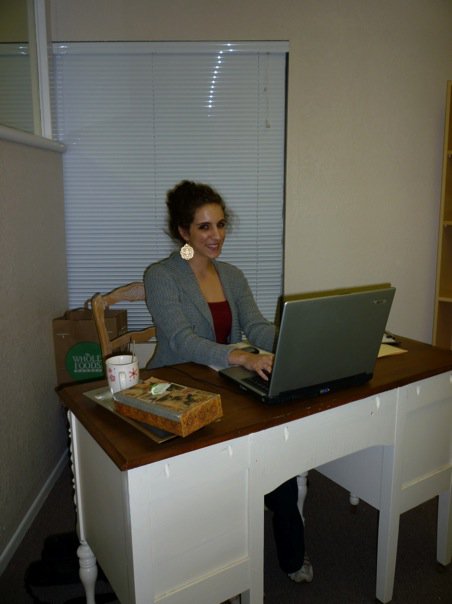
Two Roads Diverged
REST?! Not me! I don’t need it! Instead, how about I take a full-time employee position at my company less than a month after getting out of the hospital? That sounds perfect!
After all, I had gotten so good at playing a part again. The play was my life and I was the leading lady. Except this time, I had no idea what my lines were. I sashayed my way through a fake performance, never knowing the deep scars I was cutting.
It’s weird how the most mundane of moments get seared into your brain forever. I will always remember the feeling of the bristly carpet under my bare feet, me sitting on the edge of my four-poster bed in the middle of my teal-painted bedroom. I was talking to my mom about my decision to become an employee, and although I don’t remember what words were said, I do vividly remember how I felt.
A visceral, physical feeling of NO, as if I had done an intense upper-body workout the day before and someone was pulling back on those sore, tired arms while I struggled to pull myself forward and away from the grasp.
I didn’t know at the time that my body could say no without me thinking it.
I didn’t know that this visceral wrestling match should have been a warning sign from the start. I didn’t know what I didn’t know I should know.
I just kept pushing without realizing how far gone I really was.

Looking back, I clearly see how a different path could have formed in that moment of dread. How I could have started painting the dots that would have connected me to where I am now just a little bit sooner, starting right there with that carpet kissing my soles.
But, just as we can’t connect the dots of our lives looking forward, I couldn’t see clearly where my path would go, so I soldiered on. After all, I hadn’t hit rock bottom yet. Maybe I was curious what I would find there.
Why is there a Rock at the Bottom?
Nearly a year later, I was in a car with my parents and a trunk full of my possessions, heading back to my hometown of Phoenix.
If rock bottom is supposed to be a good, long cry on the bathroom floor, praying for a voice from the heavens to tell you what to do – well, that ain’t my rock bottom.
My rock bottom was taking a hard fall off my bike and feeling no pain, no adrenaline rush, nothing except the warm drip of blood down my leg.
My rock bottom was the stress you might get when stumbling upon a wild lion with its teeth bared – except the lion was the buzz of my phone and my body was conditioned to fear it.
My rock bottom was watching the barren landscape between L.A. and Phoenix fly by as I left the life I knew for the life I wasn’t sure I wanted to arrive at.
My rock bottom was a minefield of black holes and implosions.
There’s a Light
If I were to throw a theme party for what happened next in my life, I would make everyone dress in white and pretend to be onions. And because that’s NOT a real-world party people would actually attend (or would they?) and a weird analogy to begin with, let me clarify: the theme of the next stage of my live was peeling away the layers of trauma, of numbness, of lethargy, of illness and of ambivalence.
I had no idea what I wanted to do with my life. I had left behind the career I thought I’d always have, I failed at the career I tried to have, and I was left with a shell of my former energetic, creative self.

I had been exposed to deeper questions about life and meaning through my last real acting role, but I had pushed away searching for the answers away for years.
The bad thing was: I was starting from scratch.
The good thing was: I was starting from scratch.
In my attempt to start over, I did two things that made all the difference.
First, I started a blog called Urban Soul Retrieval, designing it from scratch and teaching myself web design in the process. I wrote about my experience in depth, connected with like-minded strangers on the web, and made sense of the decisions that led me to despair. My blog showed me that I could shape my story and reclaim it as my own instead of letting it write me.
The second thing I did was lots and lots of YOGA.
I had practiced yoga and off for a few years in L.A., as one does when you live in L.A..
It was the one thing in my life that made me feel really good . After a nice long stretch, I could suddenly feel a lightness that I hadn’t been able to access in so long. With a glimmer of hope coming back into my life, I followed my curiosity and enrolled in a year-long yoga teacher training.
It became the most transformative experience of my life.
At Yoga Pura (it translates to yoga “home”), everything was an experiment. It was about posing a question – who am I? – and using our minds and bodies to find clarity. My buttons were pushed, my body was stretched, and my mind was completely transformed.

It wasn’t the slightest bit fluffy or woo-woo either, in case you were wondering.
I’ve experienced the gamut of yoga studios across the country – from New Age to hardcore physical to cultish – and this one was unique. The studio owner and my main teacher was an army veteran, goatee-wearing, motorcycle-riding, chihuahua-owning man. He was blunt, extremely logical and smart, sometimes harsh, and totally empowering.
He led us to explore big things – existence itself – and small things – how to align your foot in Warrior II (and why that might help you with the big things). Through the physical practice, I built back the strength I had lost from my illness and neglect. Through the mental practice, I started to feel less like I was outside of myself.
And through it all, I was forced to face my truth for maybe the first time ever. I became intimately familiar with the swirling madness of my mind – and learned to identify thoughts and beliefs that had shaped who I had become, both the good and the bad.
We don’t often get the chance to sit and face our humanity head-on. To look at the dots that brought us to this moment we are in right now, and to draw the dots that lead us into the future we envision.
But, I’m forever grateful that I did face it – however gut-wrenching and hard it was – because what it led to was more than I could have asked for.
The Pen that Began it All
If you’ve made it this far, dear reader, you may be wondering where the entrepreneur part comes in? This is my entrepreneurial journey story after all! So, here we are at the very beginning…
During my year in yoga teacher training, I am at a coffee shop in North Phoenix and a man sitting at a nearby table is on the phone. He stands up looking for a pen to jot something down that the person on the other end is saying, so I gladly offer him mine. His call ends and he thanks me, returning my pen. We get to talking and he points at my computer and asks, “What are you working on today?” And I tell him “Just working on a graphic design for my blog.” He says “Oh, well perfect – I’m looking for a graphic designer! What’s your hourly rate?”
I threw out a number that I heard from someone once, and right there and then, he became my first client for a business I didn’t even have, but I sure as hell was going to figure out! The conversation was all-in-all maybe 5 minutes long, but it is the foundation of the business I have ran for 7 years now.
I didn’t have a plan to become an entrepreneur, but now that I am one, I know that it’s what I was always meant to be.
Fun fact: I met my husband a few years later the same way. This time, I was the one that needed a pen and he was the one to lend it to me. We’ve been together ever since, but that’s a story for another time…
We’re Back in Business
I continued to build a nice little roster of clients that kept me busy while finishing up my yoga program. I had always been a self-taught designer, so I continued to refine my skills and enrolled in a few online courses to learn the basics of two new design programs. By the time I graduated, I had enough work to go full-time with my business.
I moved into my own little studio apartment in Central Phoenix and felt a whole new me emerging – a creative, empowered freelancer who could pay my own bills through a business I had built! I felt the same rush when I signed a new client that I did when I sold my $20 beaded snake to the neighborhood boy or a handmade clothing piece from my high school website.

I started integrating my marketing experience into my design services, and soon after signed on a big retainer client. I became their Marketing Manager, leading their digital marketing program – creating content, managing social media, and developing strategies for big corporate clients. The CEO (and one of my favorite people) thought I would be a good speaker with my theatre background (and natural flair for the dramatic), so I began teaching content marketing workshops around the country.
I also continued to work with small business owners and entrepreneurs on their creative projects. From yoga teachers to artists, adventure coaches to creative, I took their ideas and brought them to life.
I observed what made entrepreneurs tick, what drove them to start their business, who they wanted to serve, and what impact they wanted to make in the world. And then I got to take all of that goodness from inside their heads and use my skillset to transform it into a platform – a brand, a website, a digital strategy – that would help them realize the deeper vision they held for themselves.
I noticed that the entrepreneurs who found the most success were the ones that were laser-focused on that deeper vision – on their purpose. They were more empowered, more assured of the value of their work, and more able to make an impact to those they wanted to serve.
I got a tingly magical feeling whenever I worked with entrepreneurs who were purpose-driven, because it was that much easier and fulfilling for me to help them bring their ideas to life. I knew I had latched onto something good…
The Big Leap
After 5 years with my biggest client, I made a big decision to move on.
I had become their Director of Marketing, was traveling to speak regularly and had built up a reputation as a content marketing expert. I had always been able to do everything as a contractor, so I could continue my creative work with entrepreneurs that I was so passionate about. But the amount of mental and physical energy it took had finally brought me place where I had a choice: go full-time and commit myself more fully or move on.
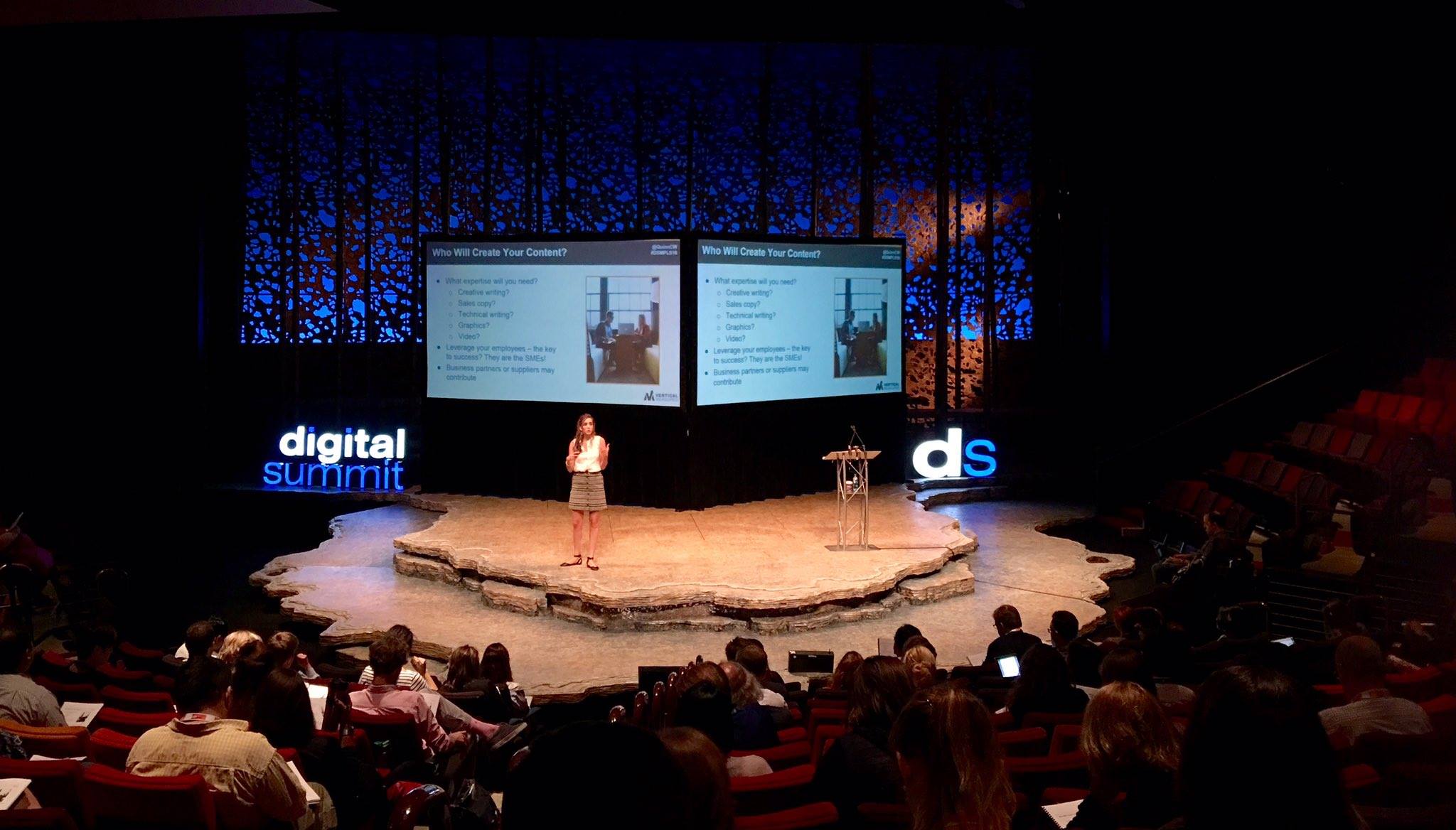
I chose to move on. I will forever be grateful for the experience because of the expertise I built in digital marketing and for the fact that I learned what it meant to bring ideas to life at a huge scale.
But, I had an itch to build something of my own, and for the first time, I had the confidence and know-how to create it for myself.
I wanted to write in my own voice about things I felt were important in today’s world.
To speak to women and work with entrepreneurs who want to build a business and a life they have always envisioned but for whatever reason have been held back.
I wanted to inspire people to uncover their purpose and bring it to life through their business.
To heal the parts of themselves they have ignored for so long.
To be aware of the traps that hide along their journey and know how to NOT fall into them
To integrate their life and business and become fully embodied and EMPOWERED
To create a platform for like-minded people across the world to share, connect, and learn from each other what it means to live and breathe their purpose daily.
What’s Next?
That brings me to this paragraph in this very first blog post on my new website. This site is the manifestation of a lifelong journey. It feels like an accomplishment in itself, yet I know that it’s also only the beginning of my journey, and hopefully yours alongside me.
If I’ve come to learn anything through writing and reclaiming my own narrative, it’s that living life with purpose is the key to empowerment. Our purpose is shaped by our experiences. It’s chiseled by pain. Informed by joy. And brought to life through intention.
Our business can be the channel to bring our purpose to life and make an impact on the world in a way it needs it most and the way we uniquely can.
So thank you for being here and reading my story. Together, let’s create a life of meaning and significance. On purpose.
Explore more blog posts

What’s Your Pace In Business?

10 Ways to Write Good Instagram Captions (with Examples + Tips!)

Planning for a Purposeful 2023 (+ My 3 Rituals!)

My 2023 Word of the Year

Is Instagram Worth it Anymore?
I’m an oldie……………….and reading your story has empowered me to think, feel, and explore. I’m touched. I love you.
Cool story. Thanks for sharing. It’s always cool to read how people find their purpose and not be afraid to push themselves to work hard for what they love.
Thanks for reading! It was a winding path for sure, but I wouldn’t trade it 🙂
Successful entrepreneurs embrace failure as a stepping stone toward greater achievements. Therealbossbabies
Leave a Comment Cancel Reply
Privacy overview.
- Get involved
Small enterprises, big dreams: Empowering women to drive India’s entrepreneurial journey
June 27, 2024.

Representative Image
Sayanika Deka, CEO of IndiMeat, knows the power of protein. Driven by a personal need to find quality protein products for her father battling dementia, Sayanika co-founded IndiMeat in 2022. Their innovative solution? Ready-to-eat meat protein bars, made with a focus on sustainability and easy digestion.
Sayanika is one of many women entrepreneurs being empowered by the UNDP-Villgro ‘Empower Her Journey’ Programme. This four-week virtual program equips women entrepreneurs across India with the skills they need to thrive.
Why Empowering Women Entrepreneurs Matters
Women entrepreneurs are economic powerhouses. Studies show they have the potential to create millions of jobs and significantly boost India's GDP. Yet, social barriers and limited access to education, capital, and networks hold them back. The 'Empower Her Journey' program bridges this gap by providing crucial training in business and digital transformation.
Since its launch in October 2023, the program has supported hundreds of women across various sectors, from climate and agriculture to healthcare and handicrafts. The program offers a unique blend of training modules, fireside chats with successful entrepreneurs and technical sessions with industry leaders. This holistic approach equips women with the knowledge and connections they need to succeed in today's digital world.
From Vision to Reality: Sayanika's IndiMeat Journey
Sayanika's background in agricultural research and her experience working with entrepreneurs perfectly positioned her for IndiMeat's success. However, it was the 'Empower Her Journey' program that truly propelled her vision forward. The program provided her with the tools and network to navigate the challenges of scaling a business. IndiMeat's impact extends far beyond nutrition.
Through partnerships with government slaughterhouses, Sayanika has empowered 40 farmers, half of them women, from the Karbi tribe in Assam. These partnerships have resulted in a 30% increase in their average income. Additionally, IndiMeat provides training on sustainable farming practices, fostering a holistic approach to community development and women's economic empowerment.
For Sayanika, the program wasn't just about learning; it was about taking action. She diligently implemented the skills she learned, from developing a robust business model to mastering digital marketing techniques. Now, with IndiMeat poised for further growth, Sayanika is eager to connect with potential supporters and collaborators.
Beyond Business: Empowering Diverse Changemakers
The program empowers women in a variety of sectors. Geetika Mehta, another graduate, tackles a different challenge: creating dignified livelihood opportunities for Persons with Disabilities (PwDs) through her venture, Atypical Advantage (AA). Having relocated to India to work with marginalized communities, Geetika co-founded AA, India's leading livelihood platform for PwDs. Their approach is simple yet powerful: focus on the strengths and abilities of individuals, not their disabilities.
Driven by a desire for structured learning, Geetika joined the program to hone her entrepreneurial skills. "The program helped me connect my personal and academic experiences, validating everything I was already doing," she says. Through AA, she has pioneered inclusive practices, organizing workshops and events that raise awareness and acceptance of PwDs in workplaces. AA has successfully generated livelihoods for over 3,000 PwDs, and their Atypical Academy equips them with essential skills for a more inclusive workforce.
Building Together: The Power of Networks
Debika Mukherjee, based in Bhubaneshwar, witnessed firsthand the challenges faced by farmers and women's self-help groups (SHGs) in India's rural sector. In 2019, she founded Divavi Enterprises - Gaaon ka Bazar to bridge the gap. This e-commerce platform connects farmers, SHGs, artisans, and weavers directly with consumers and institutions, offering a fair and transparent marketplace.
Collaborating with over 250 farmers, SHGs, and artisans, Debika recognized the need to expand her business knowledge. The 'Empower Her Journey' program provided the missing piece, equipping her with essential business, digital, and impact tools. Debika's community-focused approach, along with her dedication to understanding the unique needs of farmers, sets Divavi apart. The program's peer network also proved invaluable, reinforcing Debika's belief in the power of women supporting women in entrepreneurship.
For Sayanika, Geetika, Debika, and many other women entrepreneurs, the 'Empower Her Journey' program is more than just a training program; it's a catalyst for change. It's about empowering women, building communities, and creating a more inclusive and thriving economy.
“Villgro’s objective with Empower Her Journey is two-fold. Firstly, it provides a platform for us to share our decades of learning in fostering entrepreneurship and technical assistance, customized to cater to many women entrepreneurs across India. Secondly, this initiative also helps Villgro drive our strategic goal of increasing the participation of women in the workforce by contributing towards upskilling women entrepreneurs in digital and business skills. We are grateful to have collaborated with a similarly aligned partner like UNDP, to support 1600 women entrepreneurs scale their enterprises”.
“In the programme, I learned about mapping psychographics of customers and using digital tools for marketing. Using these concepts and taking inspiration from my peers, I created short informal educational videos for our farmers internally to bring forth the personal engagement angle while delivering bite-sized content.”
“I greatly benefited from the Virtual Fireside Chat sessions that the Empower programme organized. Listening to the journeys and experiences of other women entrepreneurs brought practical first-hand information and helped me gather ideas to implement in my own workplace.”
“The programme provided me with an in-depth knowledge of everything that an entrepreneur should know about to successfully run their business. Through the training, I was able to learn the nuances of finance, fundraising, digital marketing, and impact measurement."
- Starting Up
- Growing a Business
- Inspiration
- For Subscribers
- Write for Entrepreneur
- Tips White Papers
- Entrepreneur Store
- United States
- Asia Pacific
- Middle East
- South Africa
Copyright © 2024 Entrepreneur Media, LLC All rights reserved. Entrepreneur® and its related marks are registered trademarks of Entrepreneur Media LLC
A Guide To a Successful Entrepreneurial Journey For Aspiring Entrepreneurs Success or failure, with the right preparation and approach, entrepreneurship can be a very rewarding experience
By Prof. Srivardhini K. Jha Dec 1, 2020
Opinions expressed by Entrepreneur contributors are their own.
You're reading Entrepreneur India, an international franchise of Entrepreneur Media.
Starting a venture is exciting and daunting at the same time. The excitement of embarking on a new journey, charting a new course, being independent and in control, the possibility of amassing substantial personal wealth, making a difference in the world are all reasons to look ahead with great excitement and anticipation. But at the same time, wading into the unknown, stepping outside your comfort zone, lack of a steady and predictable income, and scepticism by those around about entrepreneurship as a career choice, can create stress and anxiety. How do you prepare yourself to undertake such a journey?
Sort out your financial situation
If you are starting out with just an idea, you can expect that it'll take your fledgling venture anywhere from 12 to 24 months to start clocking revenue or reach a stage where you can raise external funding. This means, you must be willing to go without pay for that length of time and probably invest some of your own money into the venture. If you are young and single, without many financial responsibilities, you may be able to take this on with a little savings or support from family. If you have bigger responsibilities—a mortgage to pay, schooling to support, healthcare expenses—you need to have a partner who can shoulder the family expenses or have enough saved up to keep your financial commitments. Often, entrepreneurs are too optimistic about their idea potential and underestimate the amount of time it takes to reach a point where they can start realising financial returns. It is important to give yourself and your venture a comfortable runway to take off.
Co-opt your family and friends
Entrepreneurship requires understanding and accommodation from those around you. The financial situation may impose certain constraints. For instance, foreign vacations and expensive purchases may need to be postponed. Apart from the financial implication, being an entrepreneur takes up a lot of time. It is not a 9AM to 5PM job that you leave behind when you return home. You are thinking of and working on your venture all the time, which means you may have less time and mindshare for other activities. Of course, you should manage your schedule and carve out time away from the venture to reenergize yourself. However, you also need to sensitize your family and friends about the demands of an entrepreneurial career and explicitly enlist their support. This way, when work takes precedence, it does not create unpleasantness. Also, entrepreneurship can be an emotionally draining experience as you traverse the ups and downs of building a venture. Having a strong support system will help you navigate the journey better.
Choose your co-founders wisely
Many ventures are started by founding teams rather than solo entrepreneurs. You might also be exploring starting up as a team, perhaps with a friend or co-worker. The choice of co-founder(s) is a critical decision with long-term implications. Research has shown that 65 per cent of startups fail due to conflict between co-founders. Therefore, founding team formation should be a carefully considered decision. It should be based on the competence of the individuals, their motivation for starting up, and their professional values and working styles. You might start a venture with a friend, but know very little about their professional competence and ethos. Or, you might choose a co-founder based purely on their professional experience, only to find that their motivations and working styles don't align. It is advisable to spend sufficient time upfront understanding each co-founder's motivations and professional values, and clarifying the role they would play in the venture.
Be willing to learn from the experience
We routinely read about successful startups and the fame and fortune they bring to entrepreneurs. However, the reality is that these success stories are a very small percentage in the universe of startups. In fact, a majority of them fail. They fail for a variety of reasons, some due to the decisions taken with respect to product, market and other aspects of the business, and some due to the external environment in which they operate. While success cannot be guaranteed and is often beyond the entrepreneur's control, learning from the experience is certainly possible and should be prioritized. Research has shown that in comparison to entrepreneurs who blame their failure on luck, those who make a conscious attempt to learn from their failures are far more likely to succeed in their future ventures. This does not mean that you cannot succeed the first time around. However, if it doesn't work out, the experience provides for great learning that can be leveraged for a future venture or in a corporate context where it is highly valued.
Success or failure, with the right preparation and approach, entrepreneurship can be a very rewarding experience.
Chairperson, Entrepreneurship area at IIM-Bangalore
Most Popular Red Arrow
Here's how much investing $10,000 in nvidia when it went public would be worth now.
Nvidia was founded in 1993 and went public in January 1999, first trading at $12 per share.
One of America's Oldest Companies Just Laid Off 600 Workers as it Shifts Focus to Production in Mexico
Over 600 John Deere employees in Iowa and Illinois were laid off effective August 30.
How Entrepreneurs Can Apply the 7 Laws of Success to Their Business and Personal Life
Most folks have a hard line between work and life. "It's just business," "I am a different person at work," etc. But what if we brought some of the beauty of the personal into the professional?
How to Text Customers Without Getting Sued — Your SMS Marketing Compliance Guide
SMS marketing is a growing channel, but you've got to stay compliant with regulations. Here's what to know and do.
I Created 2 Habits That Significantly Improved My Daily Life — Here's How You Can Do the Same
Good habits are a powerful way to live your best life. Here's how I created new habits to enable me to start my day off right.
This is What is Missing From Your Customer Experience Playbook
One-size-fits-all customer experience playbooks don't exist — and for good reason. Every business has distinct customers with distinct feelings, needs and preferences.
Successfully copied link
Community Economic Development
Division of Extension

Wisconsin REV Has Launched!
- Share on Facebook
- Share on X (Twitter)
- Share via Email

Wisconsin’s Rural Entrepreneurial Venture (REV) program launched on June 3 rd with its inaugural cohort diving into the first phase known as eReady. Each WI REV community’s leadership team started their journey with an orientation meeting that included their WI REV coach and eReady coach to learn about the eReady three-month process and to start reviewing the Ord, NE case study. They then gathered virtually for their first plenary session, coming together as a cohort to discuss the economic benefits Ord has seen over the past 20+ years and to reflect on potential goals their own communities might realize through employing the WI REV framework.
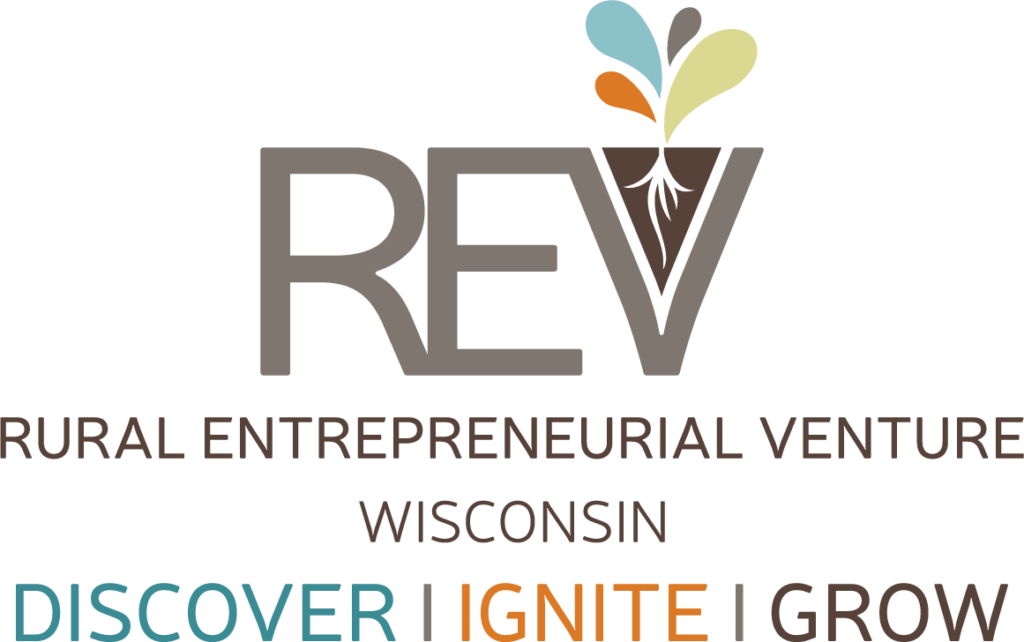
Ord is a rural city in Valley County, NE that began using this type of framework in 2000 to develop their small community through entrepreneur-led economic development. Their growth and economic prosperity have been studied and documented by e2 Entrepreneurial Ecosystems leader, Don Macke, and his colleagues for more than 20 years as ORD continues to utilize the tools this framework provides.
Rural Entrepreneurial Venture (REV), based on the e2 model of entrepreneur-led development, is a proven entrepreneurial development program designed to advance small town economies through a targeted business approach. WI REV is now underway with its inaugural cohort including:
- City of Jefferson in Waukesha County
- Latino entrepreneurs in Green County
- City of Amery in Polk County
- City of Mineral Point in Iowa County
- City of Hillsboro in Vernon County
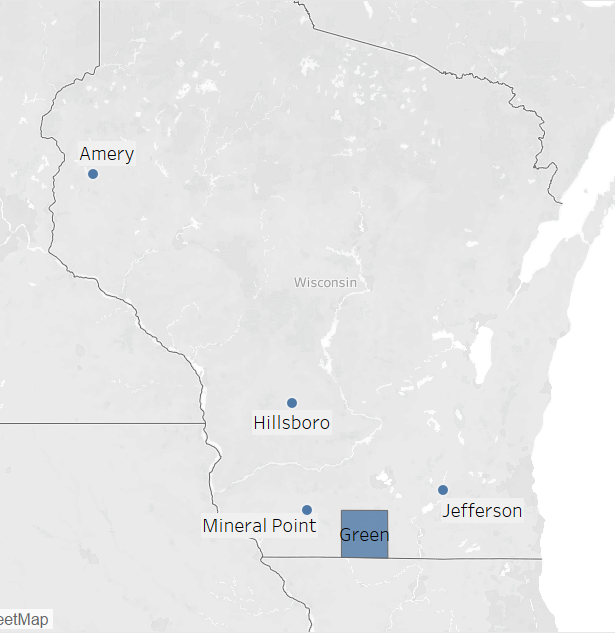
The typical WI REV community is rural with a population of at least 1,500 but no more than 10,000, which may include an individual city/town/village, a combination of neighboring communities or a school district. Local leadership in a WI REV community is willing to invest time with their local entrepreneurs and work to establish a robust entrepreneurial ecosystem and a diverse, more resilient economy. If you are part of such a community and would like to discuss potential WI REV program participation, please contact Lisa Taylor at [email protected] .
Wisconsin REV is led by UW-Madison Division of Extension’s Community Economic Development Program in partnership with Community and Economic Development , Associates (CEDA), Compeer Financial, Southern Minnesota Initiative Foundation (SMIF), and Energizing Entrepreneurs “e2” framework.
This effort is being funded by :

We teach, learn, lead and serve, connecting people with the University of Wisconsin, and engaging with them in transforming lives and communities.
Explore Extension »
Connect with your County Extension Office »

Find an Extension employee in our staff directory »

Get the latest news and updates on Extension's work around the state

Feedback, questions or accessibility issues: [email protected] | © 2024 The Board of Regents of the University of Wisconsin System Privacy Policy | Non-Discrimination Policy & How to File a Complaint | Disability Accommodation Requests
An EEO/AA employer, University of Wisconsin-Madison Division of Extension provides equal opportunities in employment and programming, including Title VI, Title IX, the Americans with Disabilities Act (ADA) and Section 504 of the Rehabilitation Act requirements.
Valuepreneurs: The New Rules for Building Products, Growing Your Business, and Achieving Your Entrepreneurial Dream (Unabridged)
Publisher description.
Got a million-dollar idea but unsure of the next steps? Stuck in your product development journey? Confused about patents or contemplating product licensing? Curious about how storytelling can win investments? "Valuepreneurs" is your go-to audiobook for navigating these challenges and more. This comprehensive guide presents the innovative Value-Driven Product Development (VDPD) process, offering a detailed roadmap from ideation to successful product launch. It's a fusion of practical strategies and real-world insights, tailored for navigating the complex terrain of product development. Integrating methodologies like the Business Model Canvas and Steve Blank's Customer Development Model, this audiobook is enriched with the author's extensive entrepreneurial experience. In "Valuepreneurs," you'll explore the intricacies of patents, learn the strategic considerations for licensing your product, and discover the power of storytelling in attracting investors. Each chapter blends theoretical knowledge with practical wisdom, underpinned by real-life examples. More than just an audiobook, "Valuepreneurs" is a mentorship journey. It addresses common pitfalls in entrepreneurship, offering guidance on staying focused and motivated. Covering everything from refining your idea to marketing strategies, it's a complete package for aspiring and seasoned entrepreneurs alike. As a special bonus, this audiobook comes with an accompanying download featuring vivid images from the book, enhancing your understanding and engagement with the content. "Valuepreneurs" is not just about creating a product; it's about building a successful, sustainable venture. Whether you're a startup enthusiast or a seasoned entrepreneur, this audiobook is an invaluable resource. Embrace the journey of turning your entrepreneurial dreams into reality with "Valuepreneurs."

IMAGES
VIDEO
COMMENTS
The “Five Stages of Entrepreneurship” is a simple framework that helps new founders to understand the entrepreneurship journey. The stages include ideation, planning, execution, scaling, and hypergrowth.
And now, to plan ahead, here are a few steps that can help you embark on your entrepreneurial journey. A Business Partner. Entrepreneurship can often be a lonely journey. Having a business...
The entrepreneurial journey begins with an idea. This idea, often born from a problem you’ve identified, should be innovative, viable, and capable of filling a gap in the market. To refine your...
Explain the entrepreneurial journey to explore and discover entrepreneurship as a career choice; Identify the steps, decisions, and actions involved in the entrepreneurial journey; Recognize the rewards and risks of the steps in the entrepreneurial journey; Self-Employment as an Entrepreneurial Journey
How to get started on your entrepreneurial journey? From cultivating the right mindset to effectively navigating business challenges, your path to entrepreneurship starts with understanding the...
The life of an entrepreneur can be great -- you're your own boss, you make the rules, you run the business. However, all of these are easier said than done. Entrepreneurship isn't an easy path.
Stuart Crainer examines the starting points of the entrepreneurial journey and some of the key stages along the way.
Key Takeaways on My Entrepreneurial Journey. Embrace failure as a learning opportunity: Understand that failures are an essential part of growth and can provide valuable lessons for future success.
7 ideas to inspire your entrepreneurial journey. Illuminate your journey as an entrepreneur with these insightful talks primed to inspire the current and future generations of female founders ready to embrace new heights of success.
We’ve identified 5 key stages of the business journey. As you grow from one stage to the next, so does what you should focus on. Keep reading to learn which stage you’re in and how to navigate...
Explore the essential steps of the entrepreneur journey. Discover strategies for success, from dream to effective business management in this guide
Embarking on the entrepreneurial journey is a profound expedition, transcending traditional notions of success. Beyond financial metrics, success involves nuanced and evolving concepts —...
Entrepreneurship is a journey, and it seems like everyone goes through it a little bit differently. Some move through the process fast, stumbling into success in a matter of weeks after...
Make your Entrepreneurial dreams a reality by mastering a proven framework that entrepreneurs use to build and finance new ventures, validate concepts, and refine their strategy in this course from Harvard Business School (HBS) Online. Learn More. July 17 - August 14, 2024. Register by July 8, 2024. $1,850. Online. Duration. 4 weeks long.
Even though the entrepreneurial journey is uncertain and unpredictable, this paper attempts to illuminate the internal driving forces that underlie the entrepreneurial process by adopting a case-based grounded theory approach by induction.
Introducing The Entrepreneurial Journey with Dave Wescott, a dynamic and insightful video podcast that serves as your guide on the entrepreneurial journey. Join Dave and a lineup of inspiring business professionals, thought leaders, and change-makers every Tuesday at 9:15 am PST on LinkedIn and YouT….
2.0: Prelude to the Entrepreneurial Journey and Pathways; 2.1: Overview of the Enterpreneurial Journey; 2.2: The Process of Becoming an Enterpreneur; 2.3: Enterpreneurial Pathways; 2.4: Frameworks to Inform Your Enterpreneurial Path; 2.5: Key Terms; 2.6: Summary; 2.7: Review Questions; 2.8: Case Questions; 2.9: Suggested Resources
It takes a delicate balance of skill, hard work and instinct to grow a successful business. This serial entrepreneur loves the unique challenge; here are the key lessons she's learned along the...
To speak to women and work with entrepreneurs who want to build a business and a life they have always envisioned but for whatever reason have been held back. I wanted to inspire people to uncover their purpose and bring it to life through their business.
In this episode, our host Monica Hernandez welcomes Bisila Bokoko, a dynamic entrepreneur with an inspiring journey from her roots in Spain and Equatorial Guinea to becoming a global business influencer in New York. Dive into a discussion that covers the nuances of taking businesses global, the power of entrepreneurial mindset, and the unique ...
Here are six important things to keep in mind throughout your entrepreneurship journey: 1. Vision. As a startup entrepreneur not having a clear vision is like sailing a ship without a compass....
Sayanika is one of many women entrepreneurs being empowered by the UNDP-Villgro ‘Empower Her Journey’ Programme. This four-week virtual program equips women entrepreneurs across India with the skills they need to thrive. Why Empowering Women Entrepreneurs Matters. Women entrepreneurs are economic powerhouses.
The excitement of embarking on a new journey, charting a new course, being independent and in control, the possibility of amassing substantial personal wealth, making a difference in the world...
Entrepreneurs are fast becoming the superstars of our era, inspiring millions of young people to pursue the entrepreneurial path rather than the conventional corporate career.
Wisconsin’s Rural Entrepreneurial Venture (REV) program launched on June 3 rd with its inaugural cohort diving into the first phase known as eReady. Each WI REV community’s leadership team started their journey with an orientation meeting that included their WI REV coach and eReady coach to learn about the eReady three-month process and to start reviewing the Ord, NE case study.
More than just an audiobook, "Valuepreneurs" is a mentorship journey. It addresses common pitfalls in entrepreneurship, offering guidance on staying focused and motivated. Covering everything from refining your idea to marketing strategies, it's a complete package for aspiring and seasoned entrepreneurs alike.